ALLIGATOR
BEHAVIOR page 5i: BABY
ALLIGATORS --page 9 Alligator nests and babies page 1
2
3
4
5
6
7
8
10
11
12
This
page
was born 05/30/2022. Rickubis designed
it. Last
update: 12/09/2022
Images
and
contents on this page copyright ©2022 Richard M. Dashnau
Most of these were
posted on the RICKUBISCAM
page first, then moved here.
From Brazos Bend State Park
on 11/06/2022
It
took a while for me to find the gator mom near the Observation
tower. She'd moved away from the culvert by the tower.
She
was in a clear spot next to a partially-uprooted plant.
Another
alligator was also visible about 10 yards behind her. It
remained there
for a few hours, then moved under the plants.




I
wasn't sure that I'd found the mother until babies gators
started to
appear. I stayed in this area for most the the day, and tried
to point
out the babies to passing park visitors. As time passed
more babies appeared, and climbed out of the water.




Anyone
with binoculars or a camera that could reach out was treated
to a
better view, but the babies were visible without aid--just
really
small. .




My
last effort was to shoot a line of images so I could stitch
them
together. I didn't find out how many baby gators were
there
until
after I'd examined those images. There were at least 19
baby gators
out there! I've numbered them in the second image below.
Or
at least most of them. Mom gator is in front of the roots.
Over the last few weeks, I've seen various Great Blue
Herons
and
American Bitterns hunting in that area. I watched the mother
chase off
a bird two separate times (didn't catch on film). This is the
largest
number of babies in this pod that I've seen since I
started watching
for them. I had thought that the 4 or 5 at a time that I'd
been seeing
were the only survivors of various attacks by the bird. I was
happy to
be wrong. There was some exciting stuff
that happened soon after, documented on other pages.


From Brazos Bend State Park
on 09/18/2022
On
8/28 and 9/04, I could see the mother alligator with
babies
near her nest on the Spillway Trail. I couldn't find them on
the
next weekend. On 9/18/2022, I found her again (at least
I'm
pretty sure it's her). She had moved about 70 yards to the
West of the
nest. It was about 9:00 am, so the air wasn't too hot.
The babies were pretty active, so I shot some video and some
pictures.
I'm sharing some of them here. I've
edited
the video into this file.
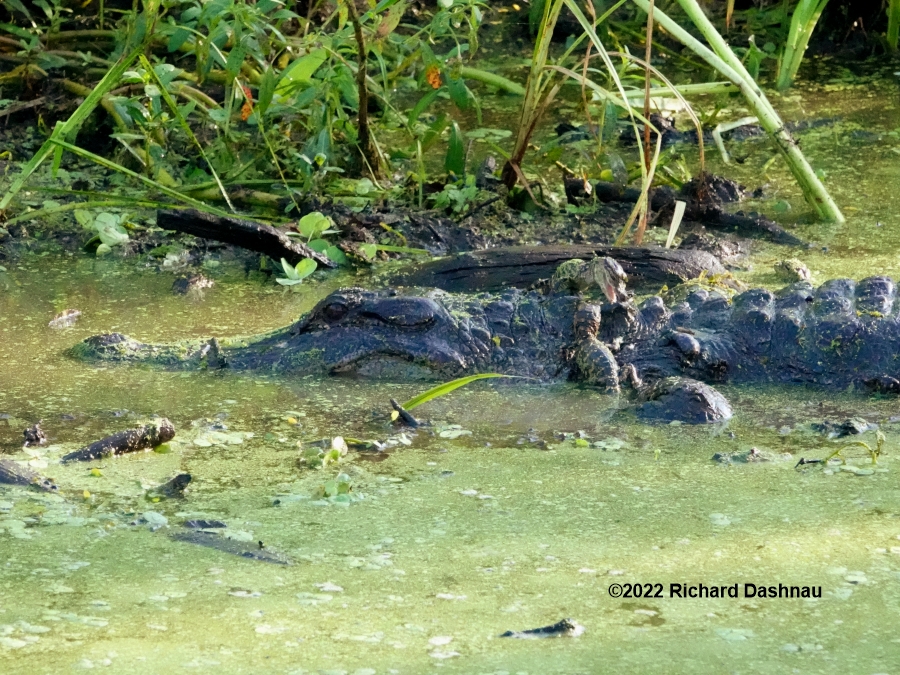
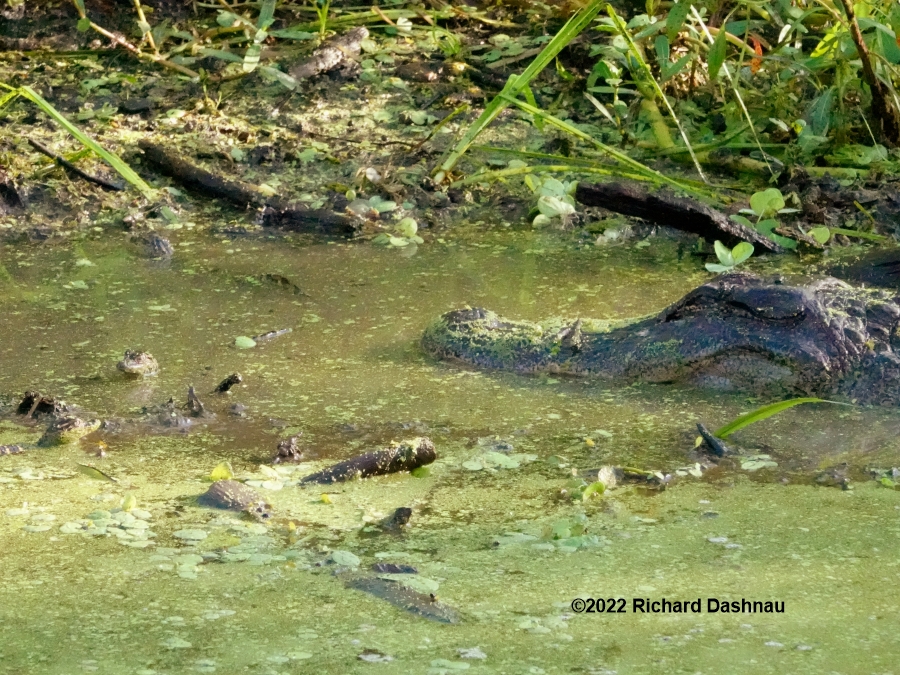
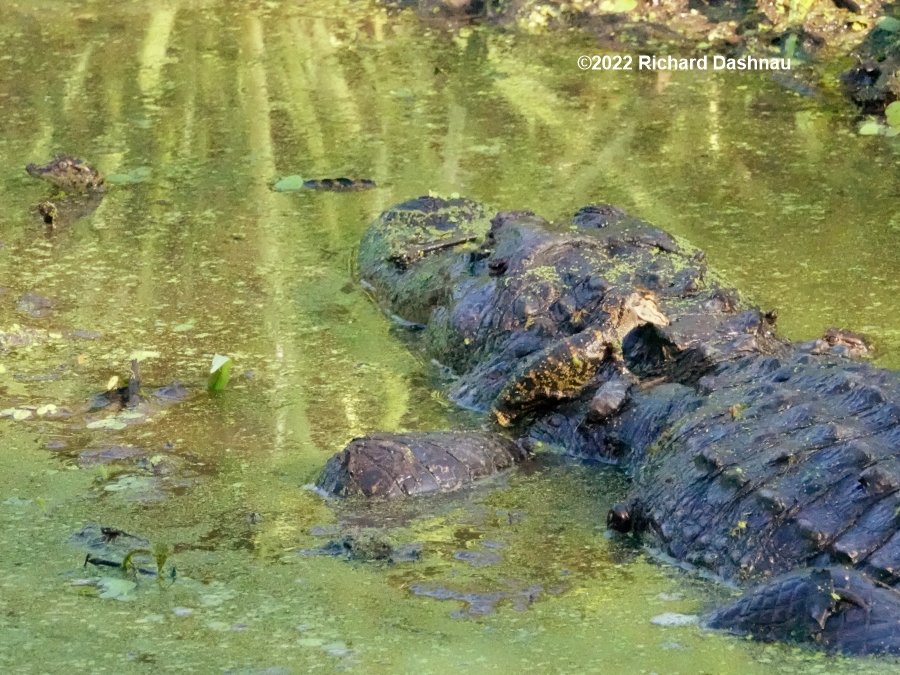
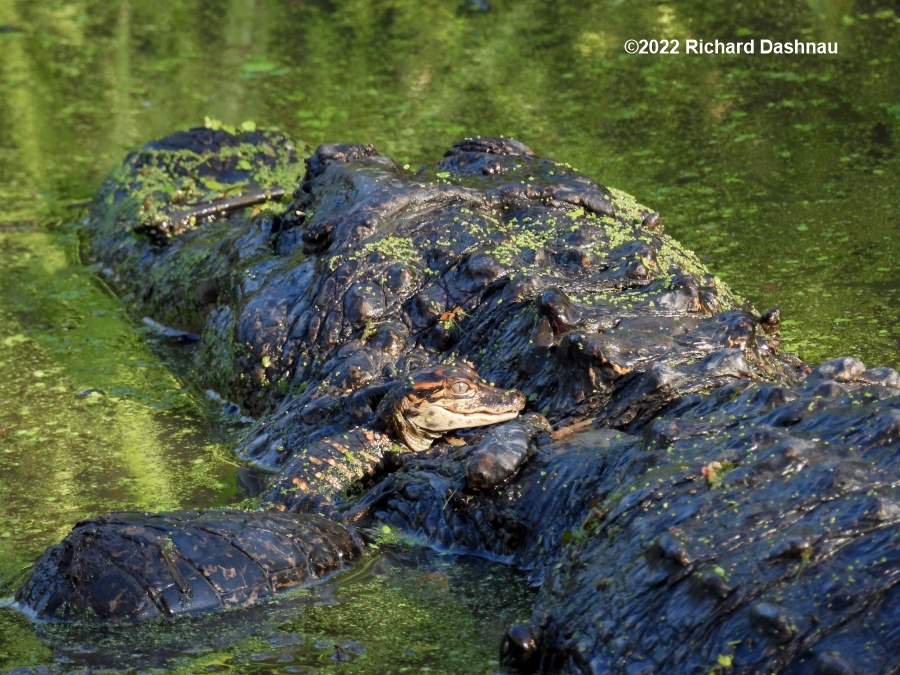
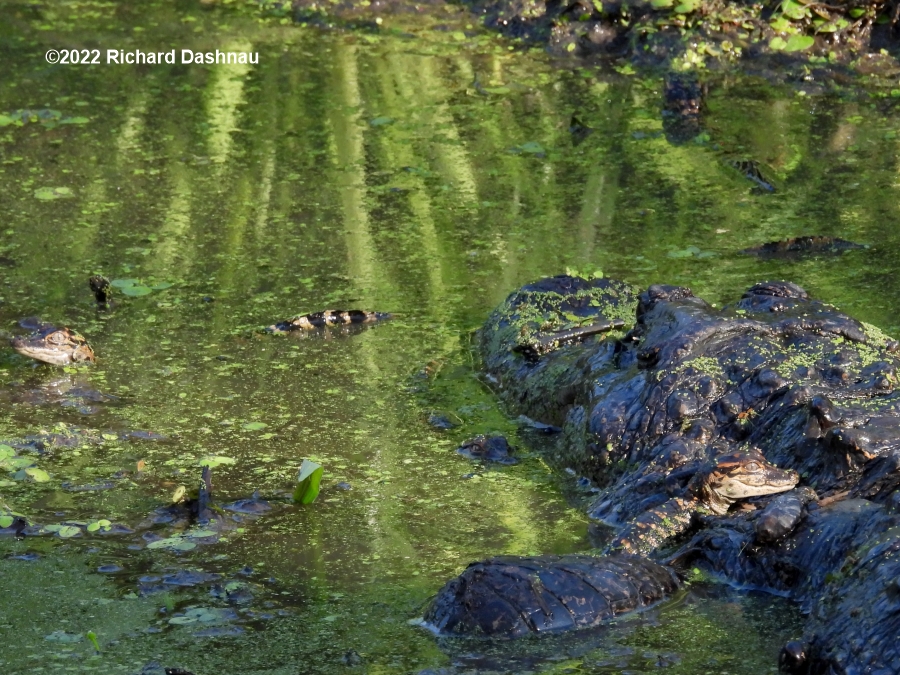
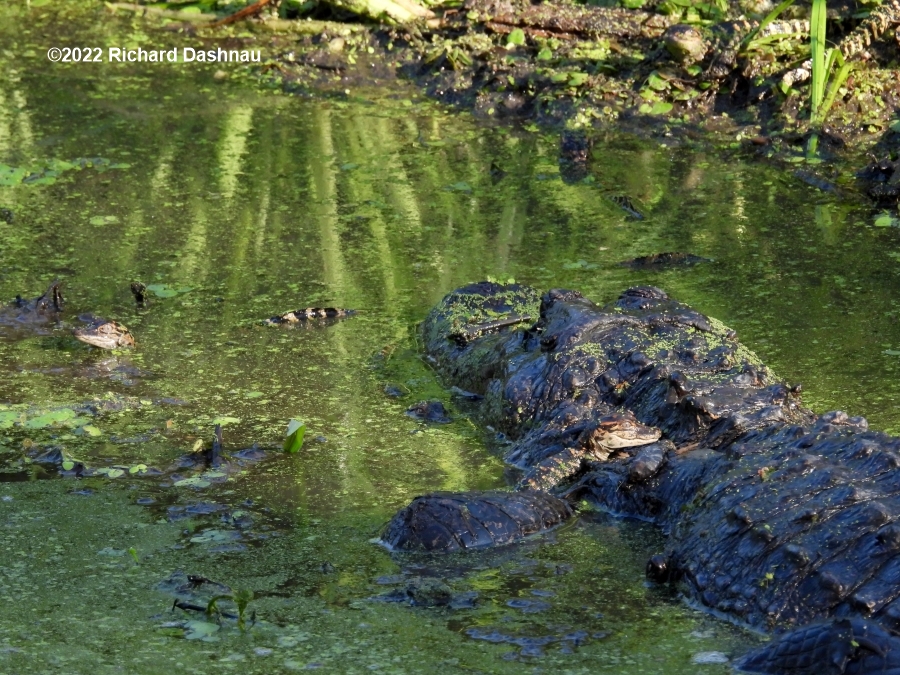
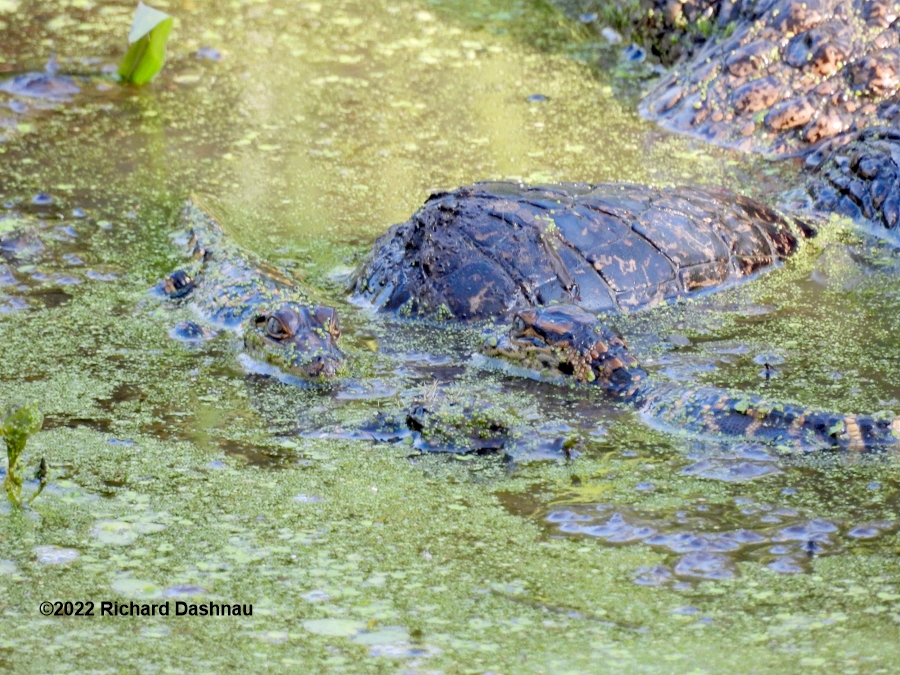
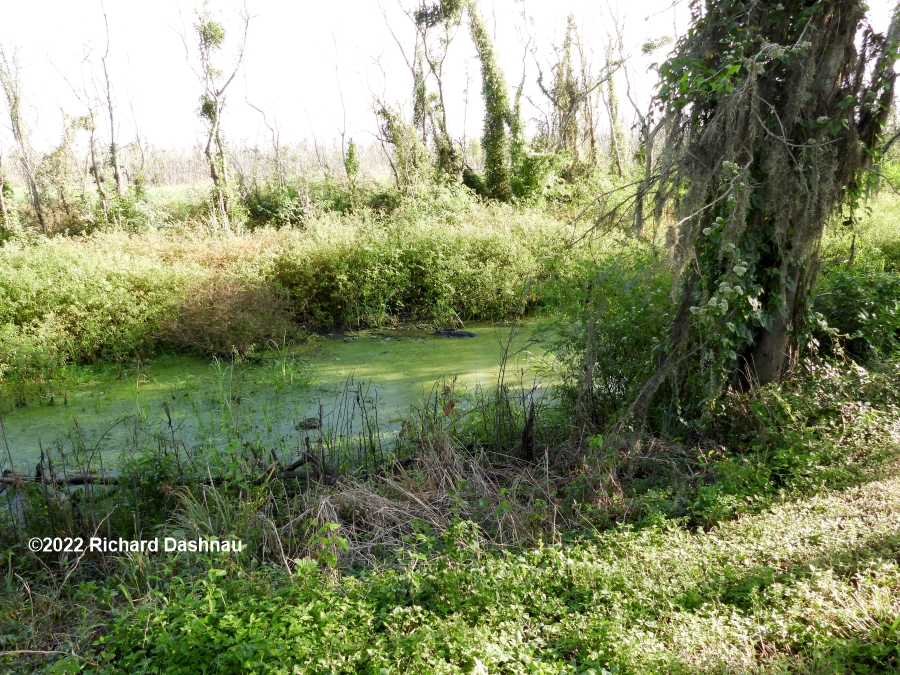
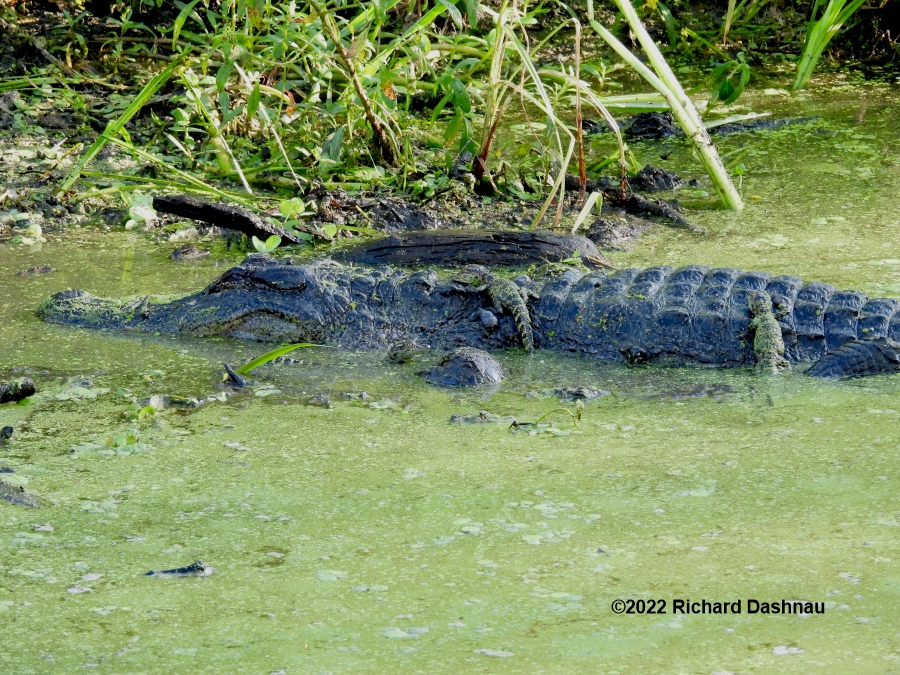
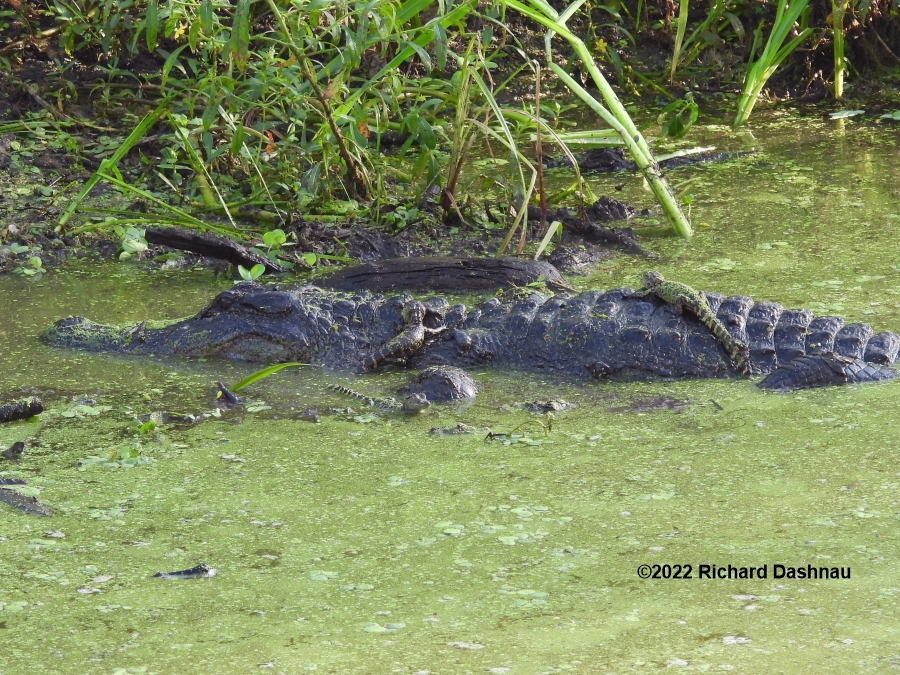
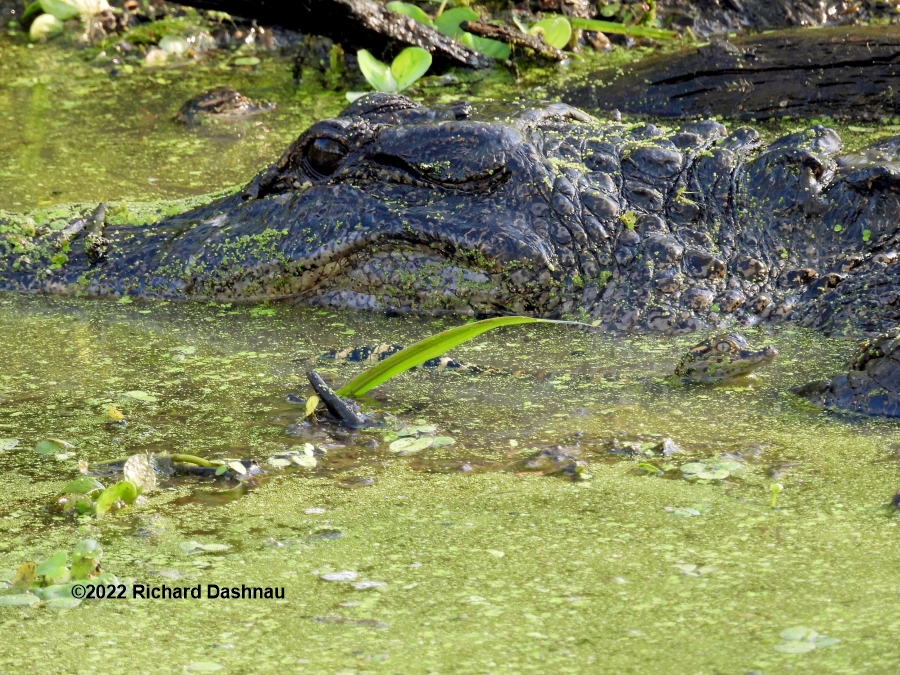
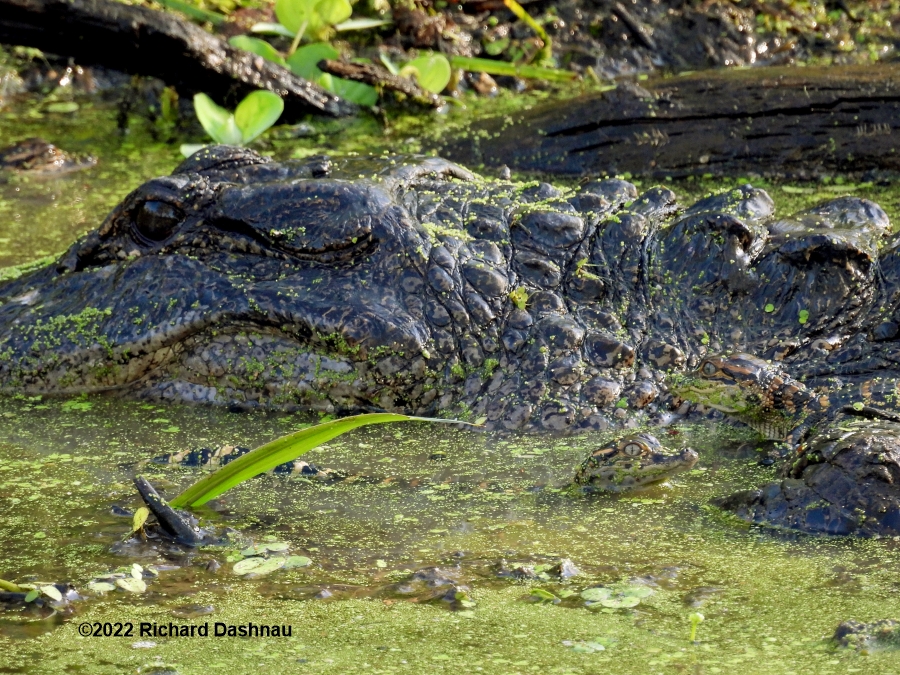
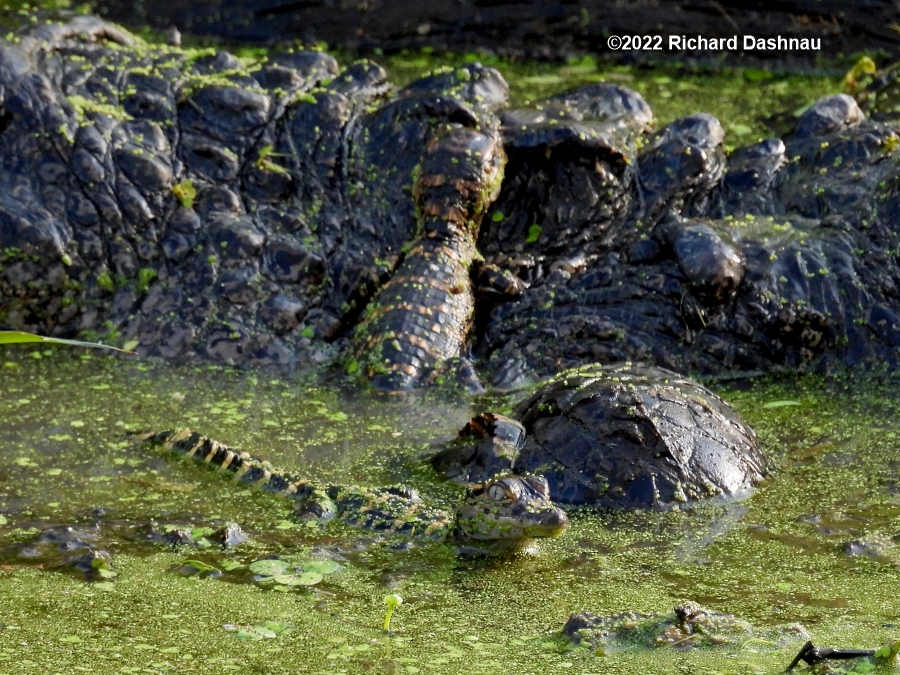
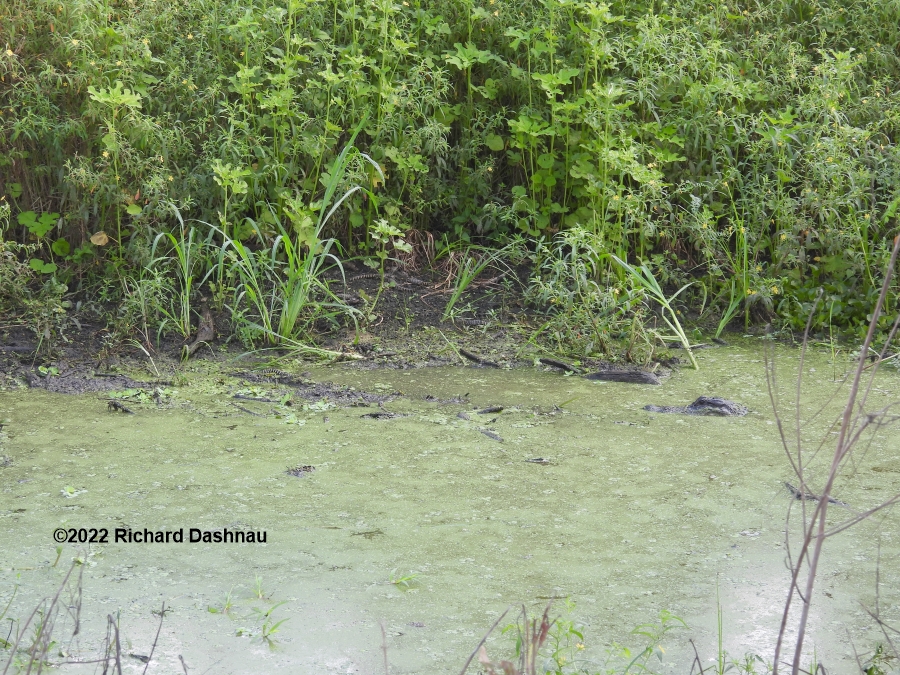
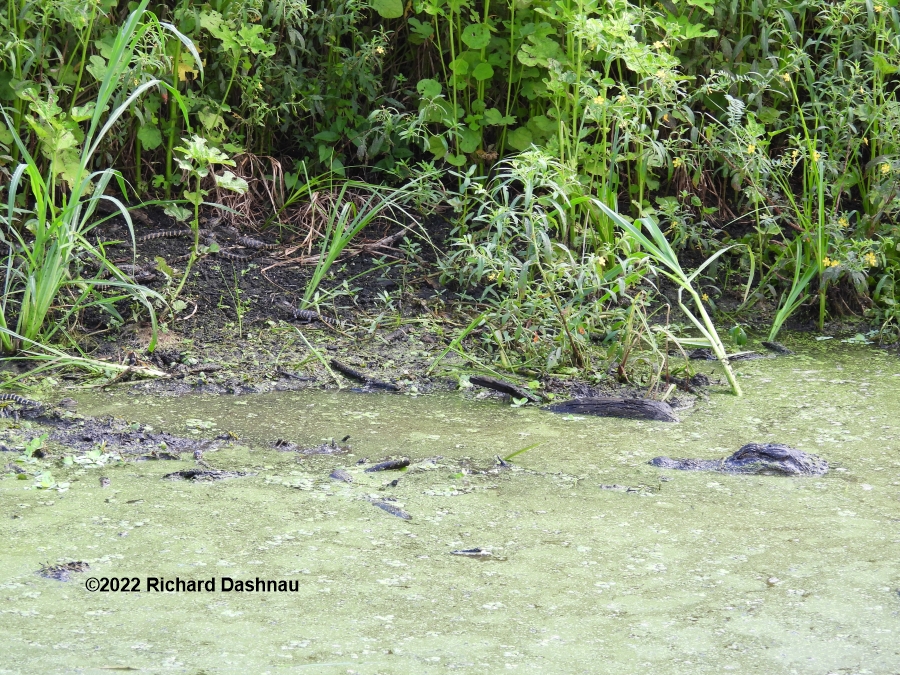
The
baby gators foraged in the water, and on land (in the video, one
walked
out of the plants with something in its jaws, entered the water,
and
ate whatever it had caught.). Some of the
babies foraged *on their
mother*. I've seen other baby gators picking at objects on their
mother's skin many times. But I've never really gotten a
good
look at what they were picking at. Baby
alligators move very
quickly while they're hunting and feeding. That, plus the
minuscule
size of the prey, make it very difficult to discover what
they've
caught. On a few occasions in the past
it seemed that the
baby gators were pulling on leeches (or at least something
"stretchy")
that were attached to the mother's skin. In one of the
clips
I
filmed on 9/18, I've captured one of the
babies pulling at
something that flexed, stretched, and snapped back when the
gator lost
its grip. This looks like a leech to me--specifically the flat,
non-swimming type. *A "turtle leech"
possibly a Placobdella
sp.(?)). I've tried to crop some frame grabs, and I'm
attaching
some those among the others here. Alligators are often
hosts
for
various species of leeches. I've
frequently seen them attached to
alligators. Sometimes they are clustered on wounds. Other
times,
they are attached inside an alligator's mouth. They can be
anywhere.
The "free-swimming"
species are visible (to me, at least).
What surprised me was the discovery that species of "turtle
leech" also
ride alligators. Those leeches don't swim very often, and are
very
well-camouflaged.
I would guess that alligators carry at least a few leeches
all the time.
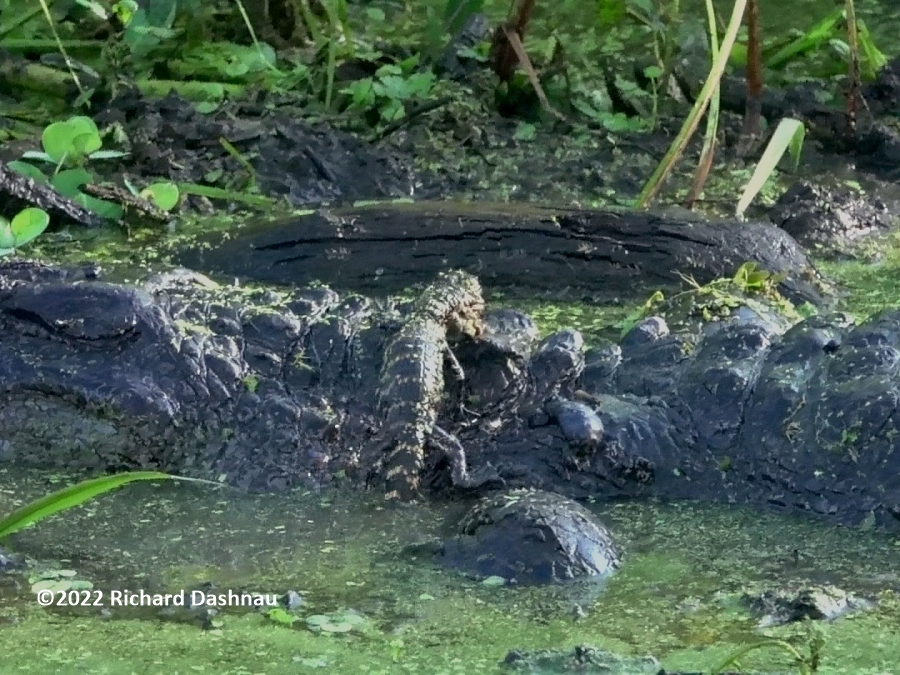
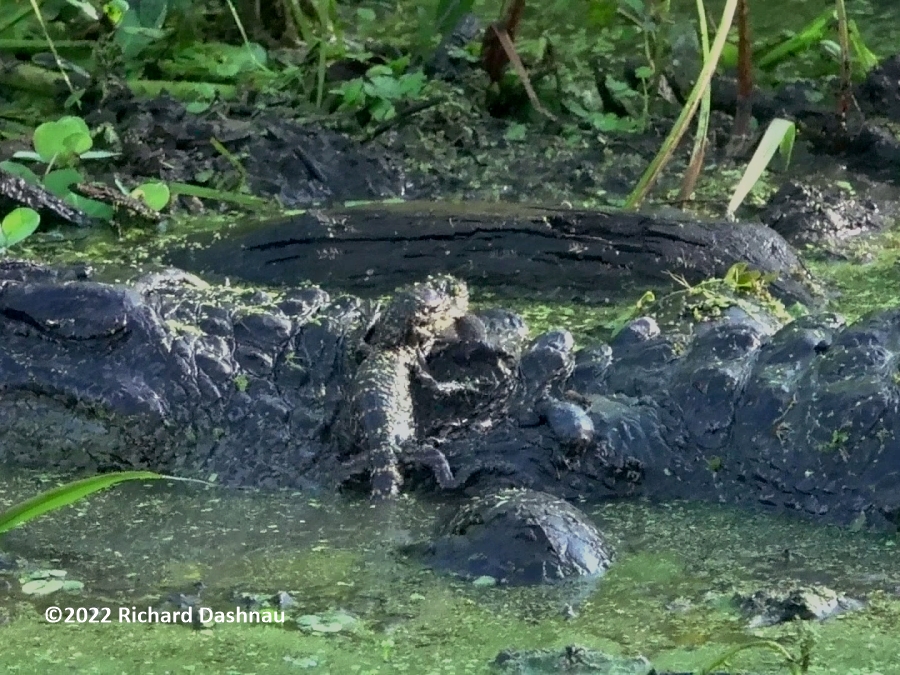
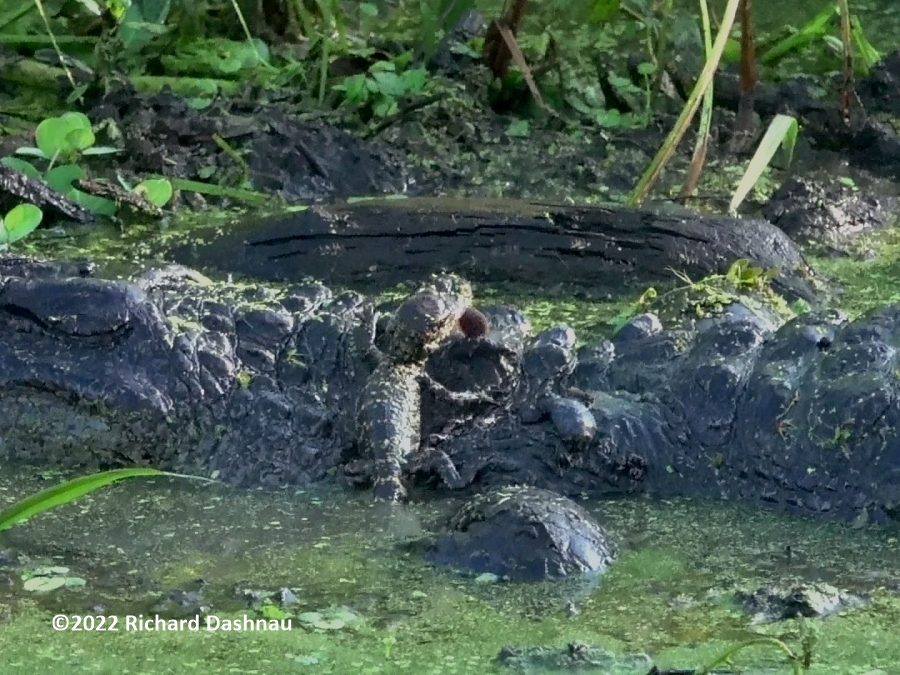
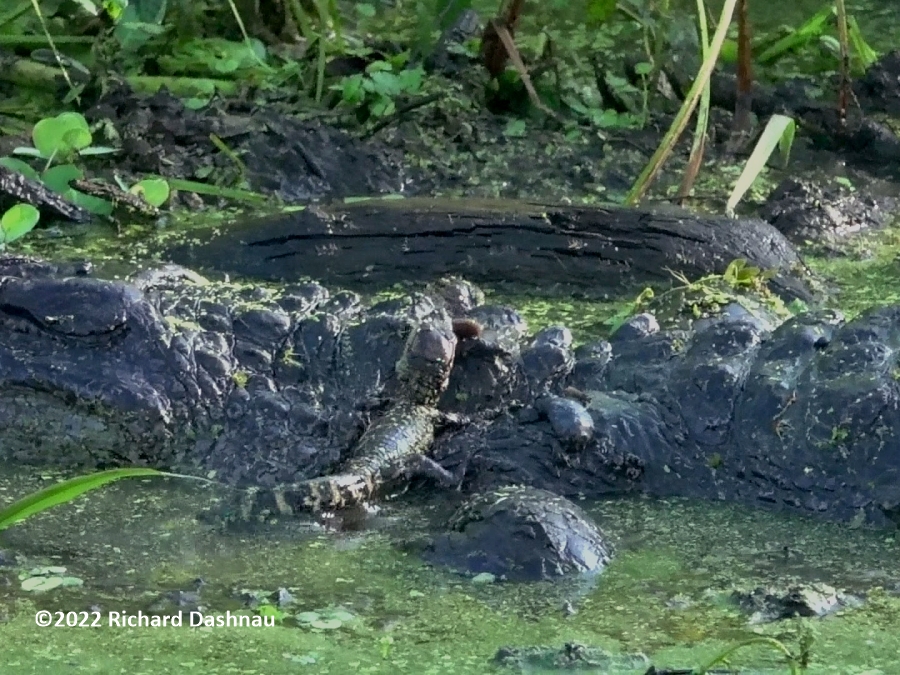
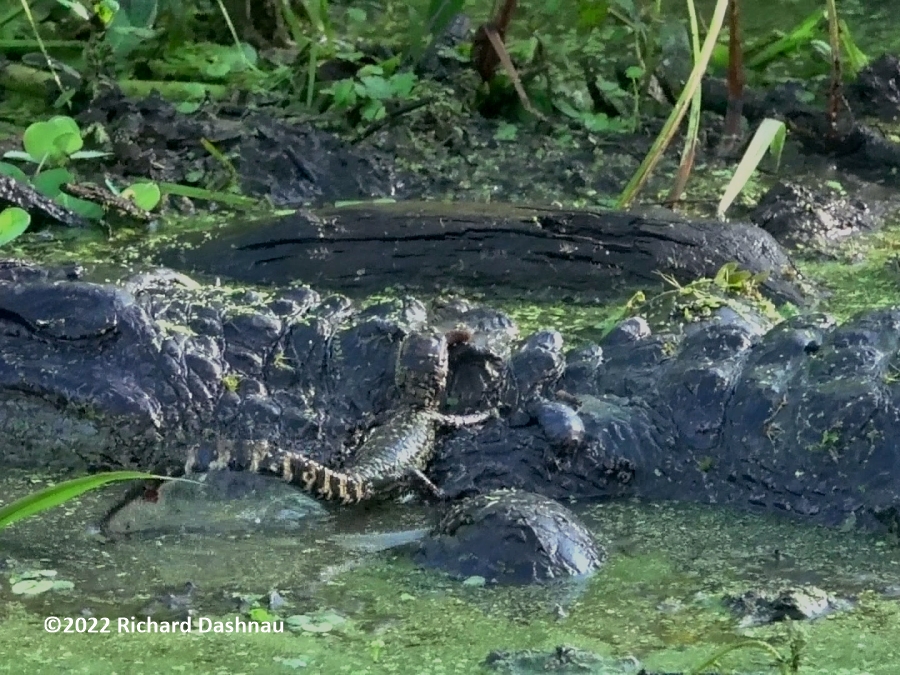
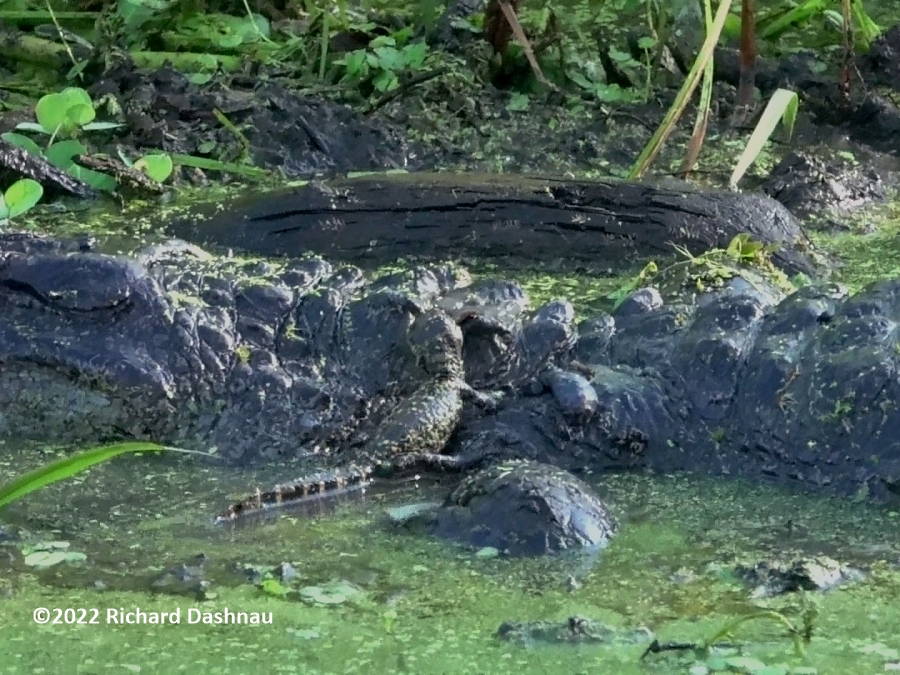
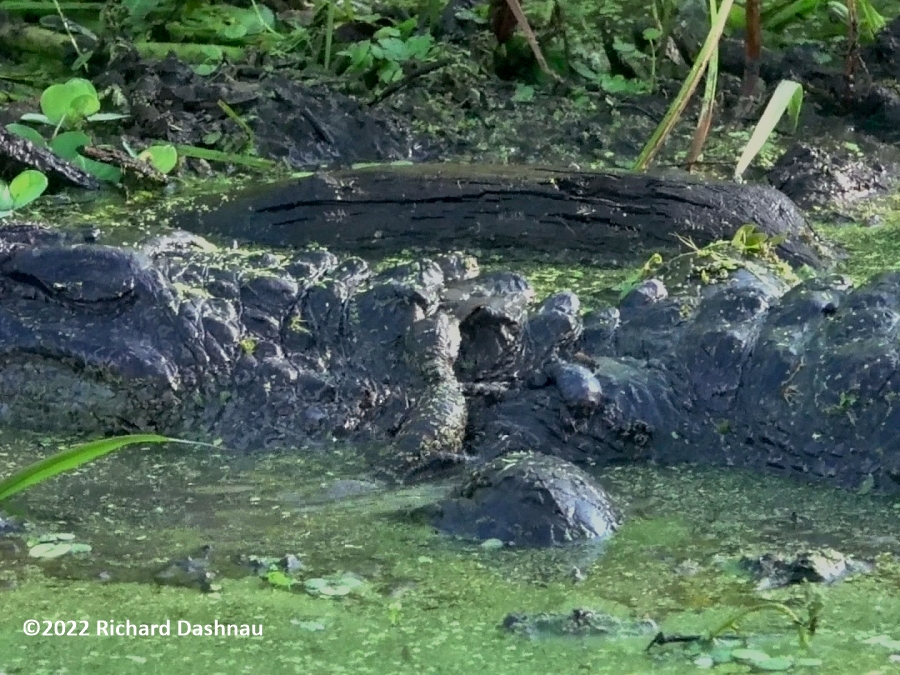
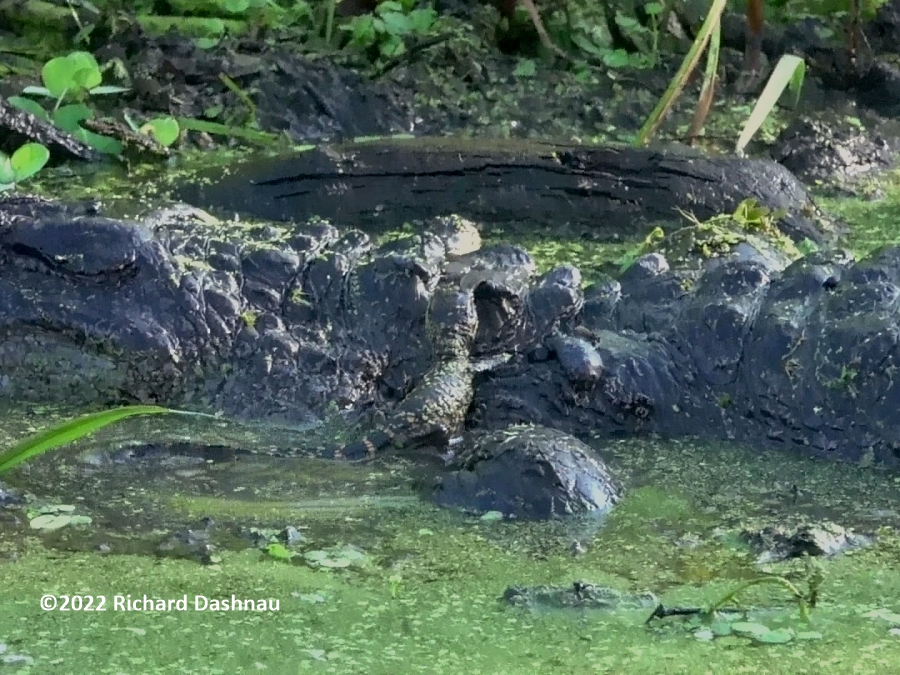
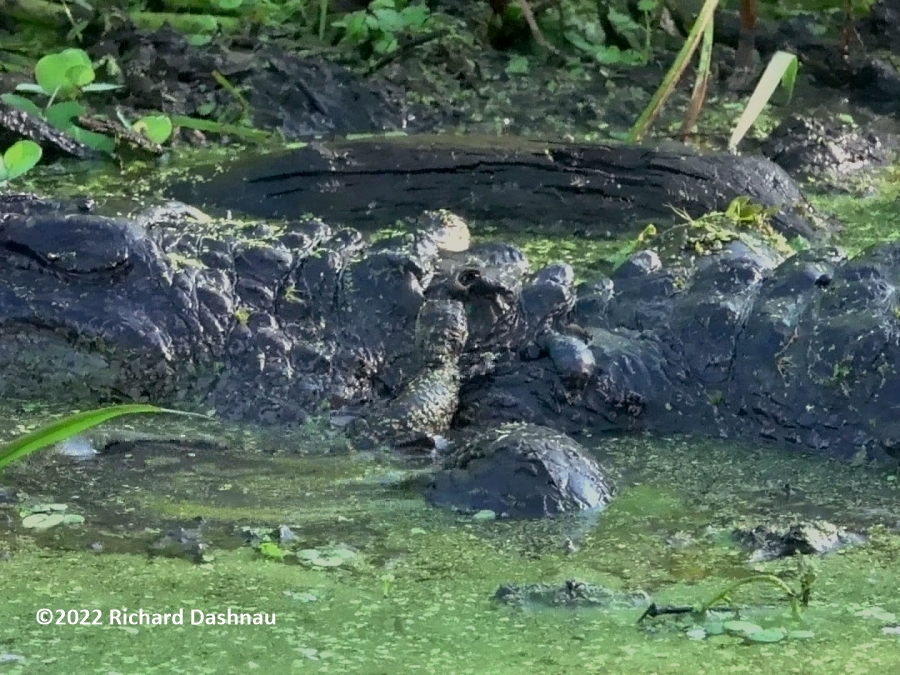
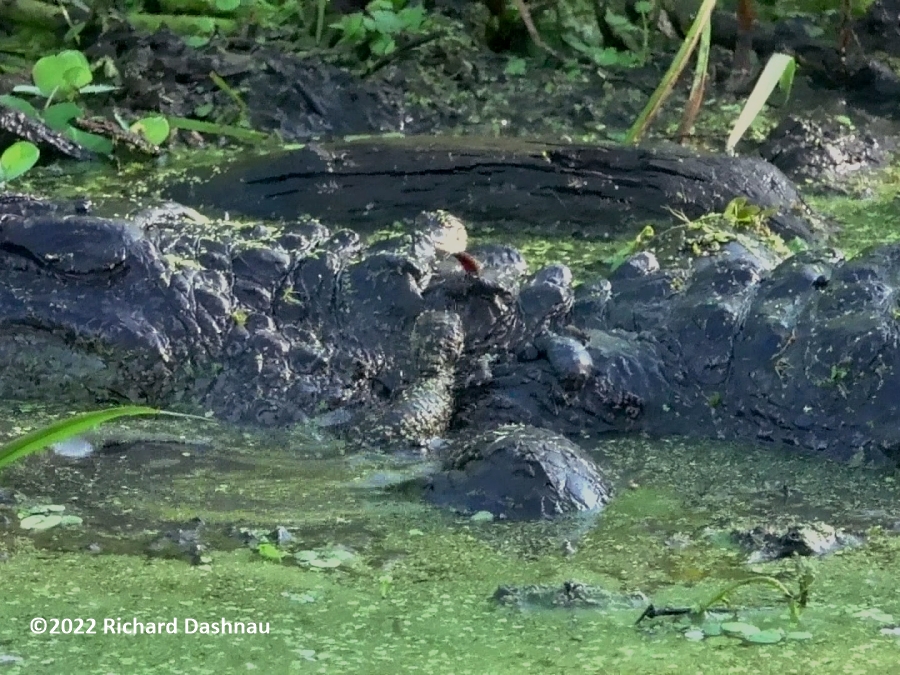
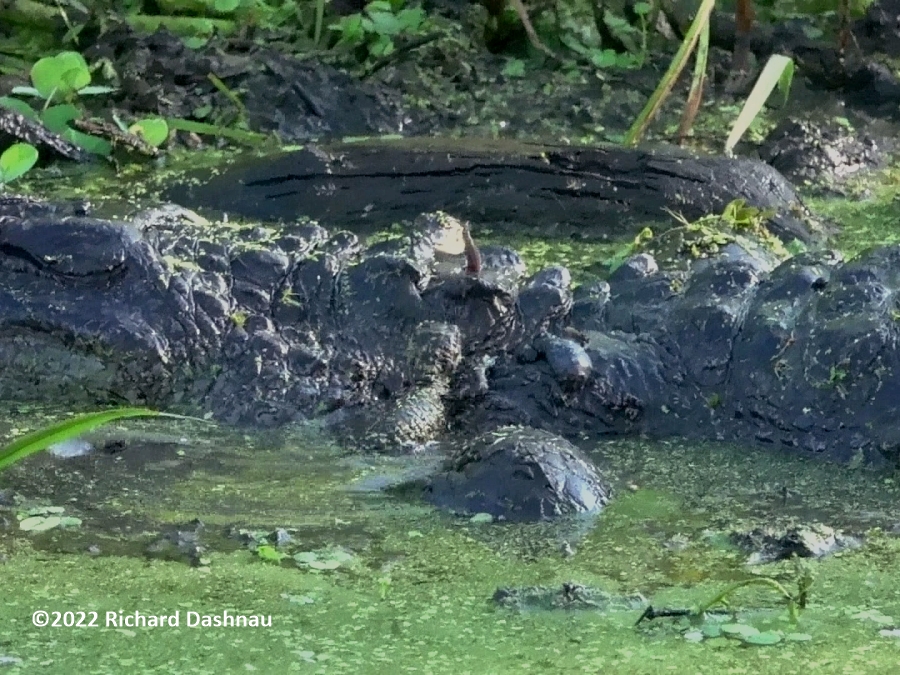
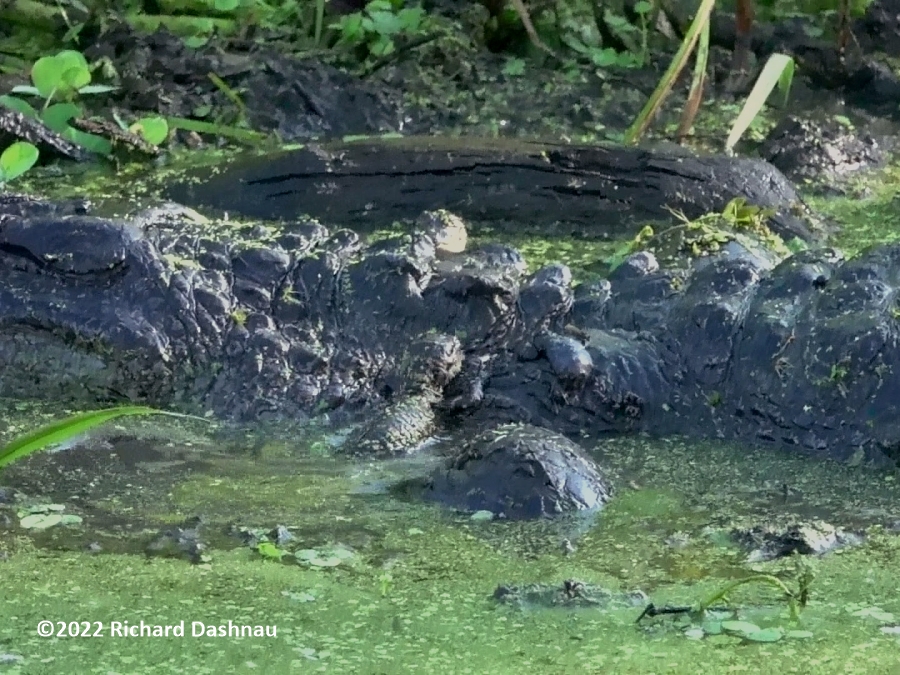
From
Brazos Bend State Park
on 08/28/2022
Over the last week,
around 5 inches of rain fell on Brazos Bend State
Park. While that wasn't enough to restore a lot, that
water made a
big difference in 40 Acre Lake, Pilant Lake, and the North
Side of the
Spillway Trail (that's all I know about, because that's where
I
went). I had just gotten to the gator nest on
the Spillway,
just before a local hiking group arrived there. As I described
the nest
to the group (it was hard to make out, especially after the
denser
greenery caused by the rain) I noticed
something white on the nest,
but couldn't tell if it was an eggshell fragment, or fungus.
The nest
also appeared "flatter", but the rain might have done that.
While
I was describing various
facts about the nest, and pointing out the
head of an alligator in the water in front of it (YES!
WATER!), one of
the group members said they saw movement. I took a close
look
around
the alligator and found baby alligators near her!
Wonderful! After the group left, I spend
more time
trying to photograph the mom gator and her babies. Some of the
photos
are below.
There is a video edited from materials I filmed today, and you
can see video here.
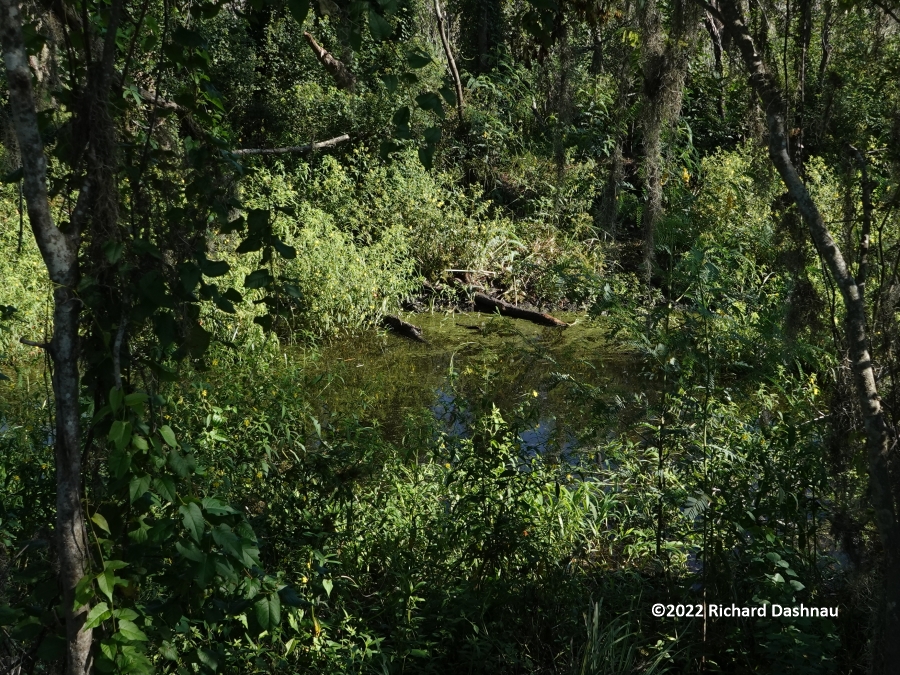
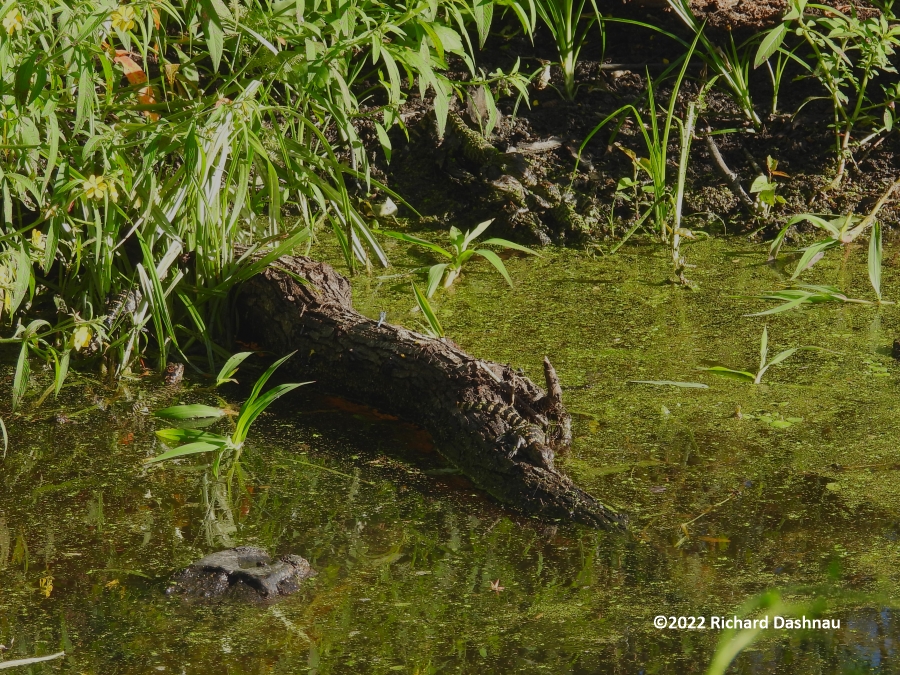
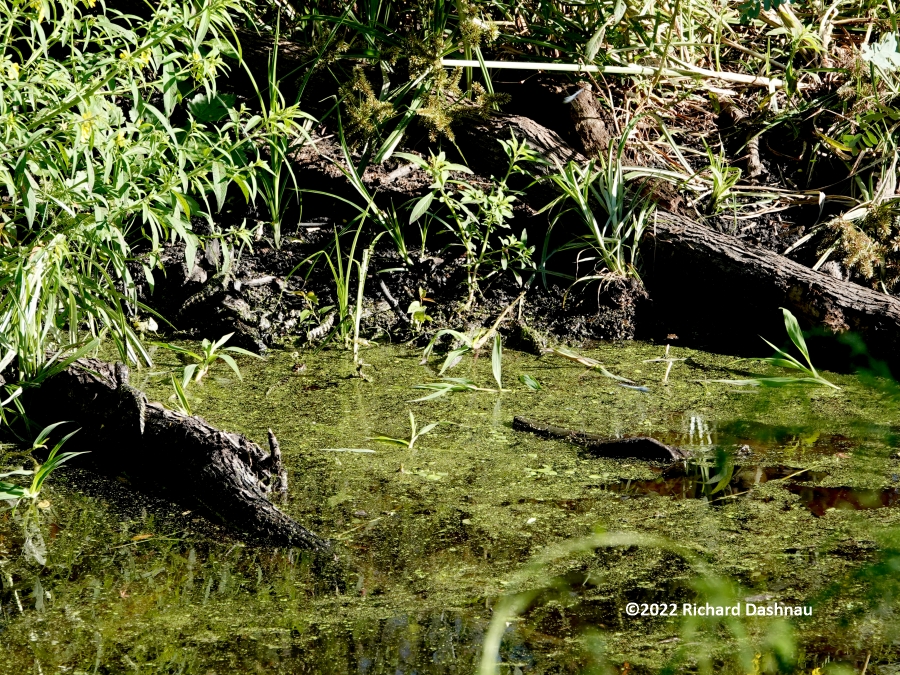
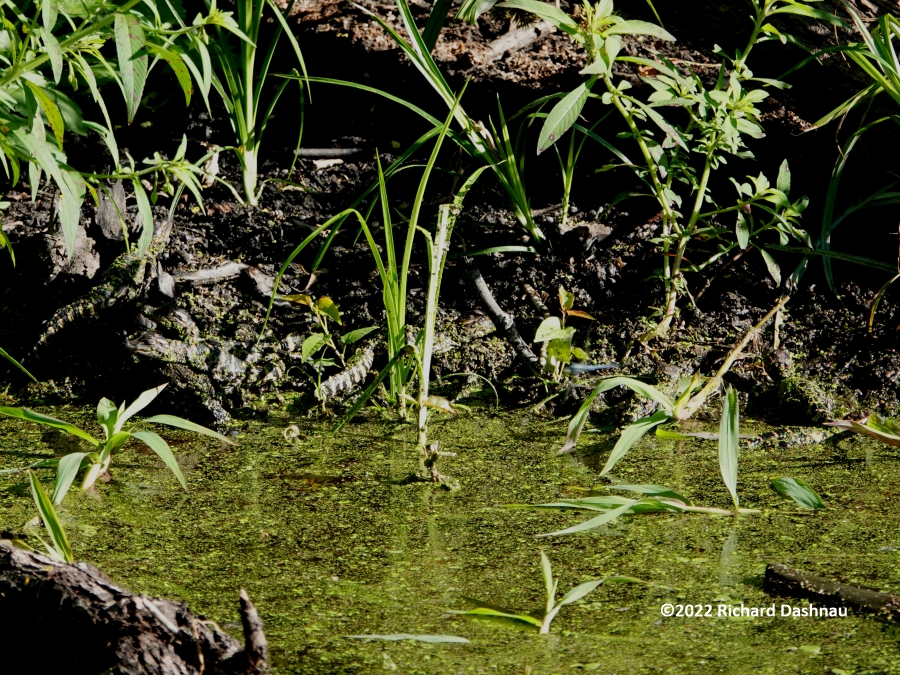
This
was about 9am, and the sun was off to the right (East). I did
the best
I could. I didn't see a huge pile of babies, and I couldn't see
them
well, even with magnification. For the "end on" log
view, I moved further to the right, and shot through a gap in
the
branches and leaves.
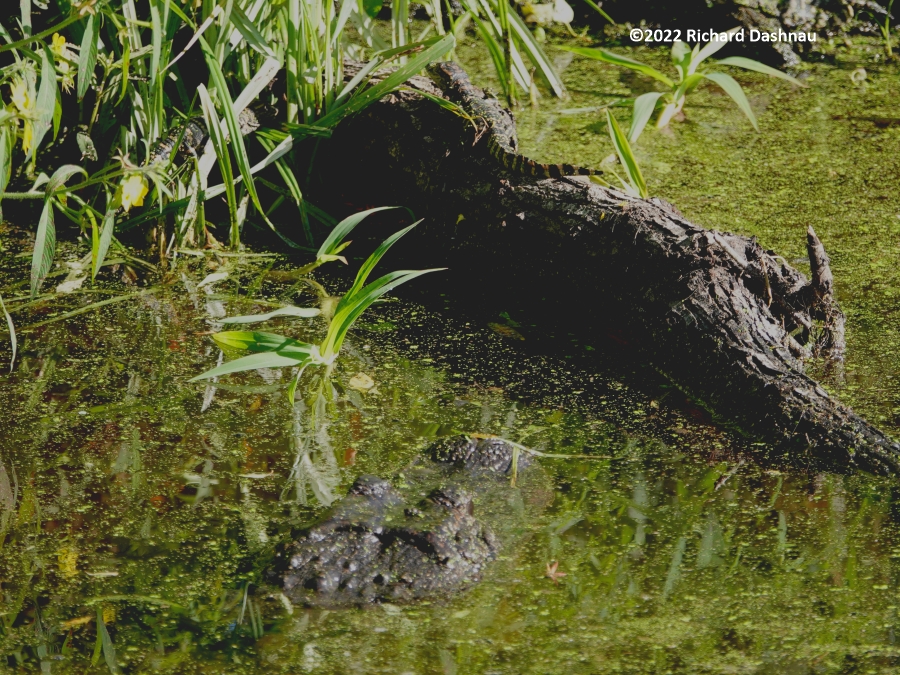
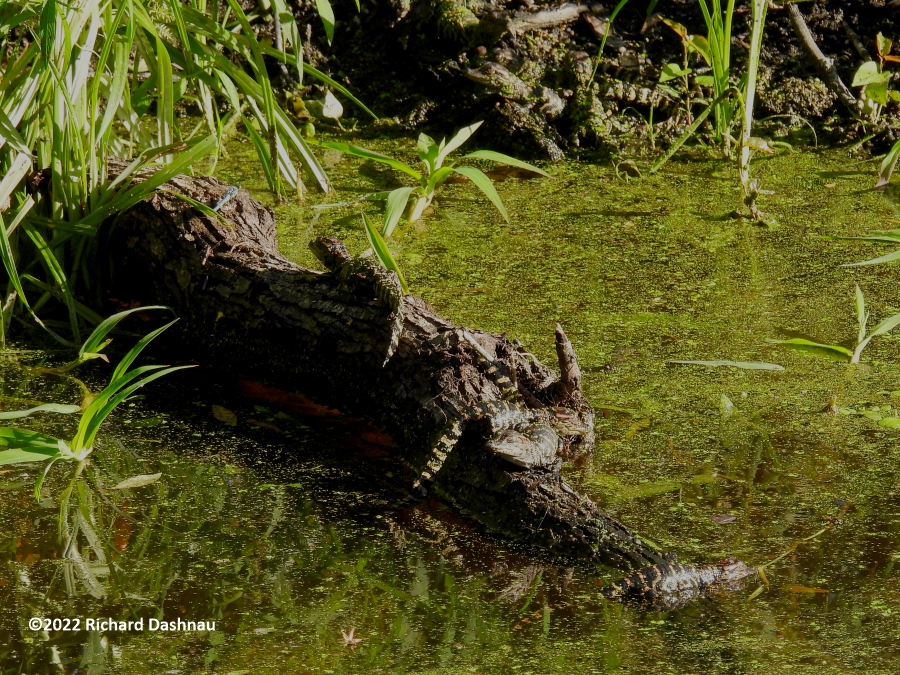
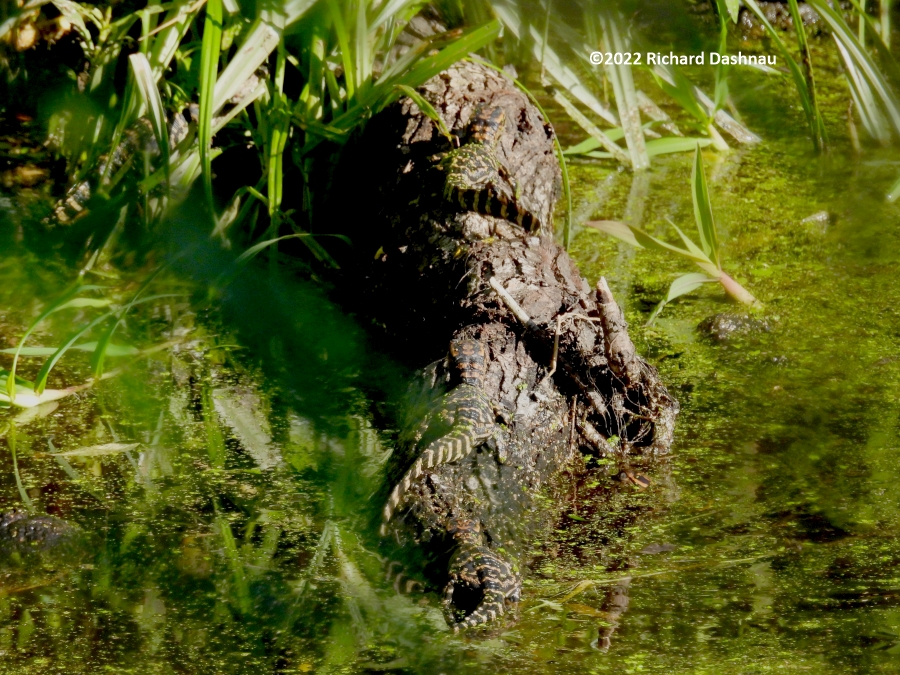
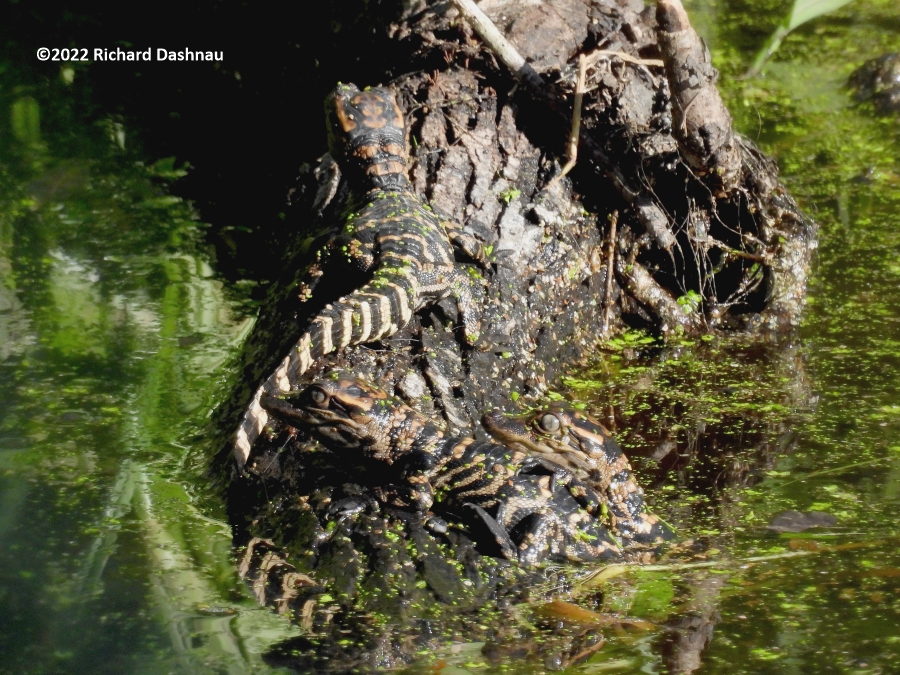
Then
the mother showed more of her back and head, and she began
bellowing.
She did a "bout", of 8 bellows in a row. Then stopped. After 3
minutes,
she did another
bout of 6 bellows;
and a minute after that, a third bout
of 6! I listened (and I sure she was, too) for answering
bellows.
After the 2nd bout, another alligator bellowed a bit
further
East, on the other side of the
Spillway Trail. I couldn't find it.
The mom gator answered right away, and bellowed six more times.
Later,
some visitors coming from the West told me they'd heard
alligators
bellowing in
40-Acre Lake, a little before they heard the ones
near me. I watched the baby gators, and they didn't
seem to
react at all during the bellowing. But, standing still could
have been
the reaction-
not
moving and letting their striped camouflage
work. Three images show the area between two bellows--and
the
babies haven't moved much. It had been a very interesting
morning; but
mom gator had a few more things to do.
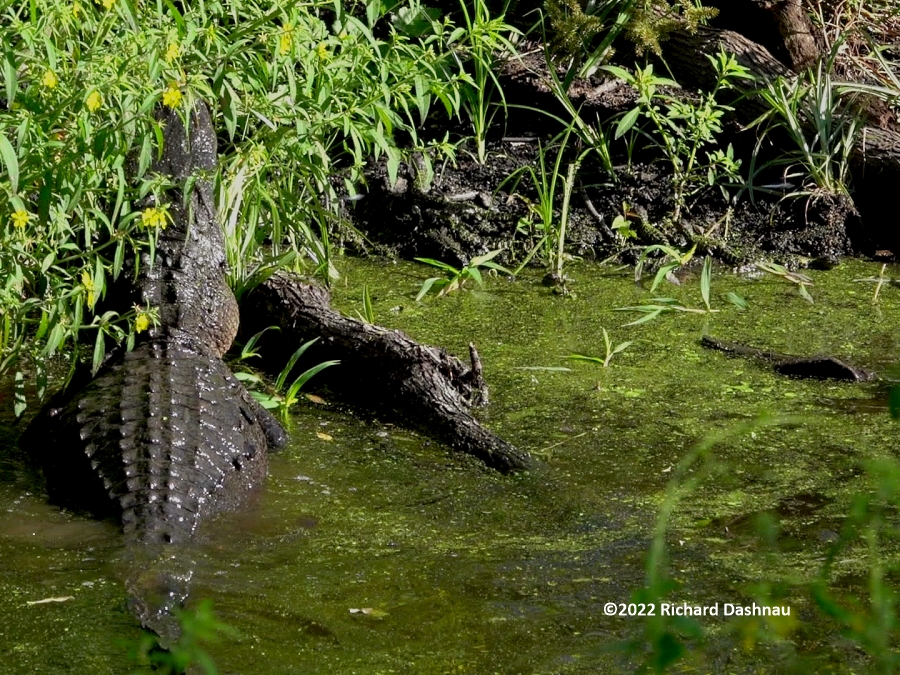
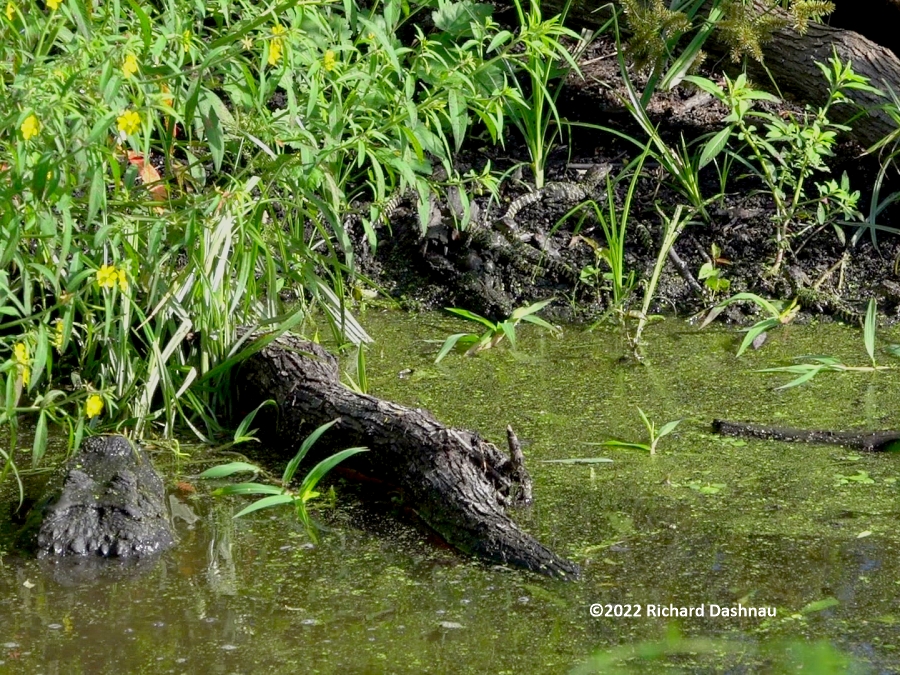
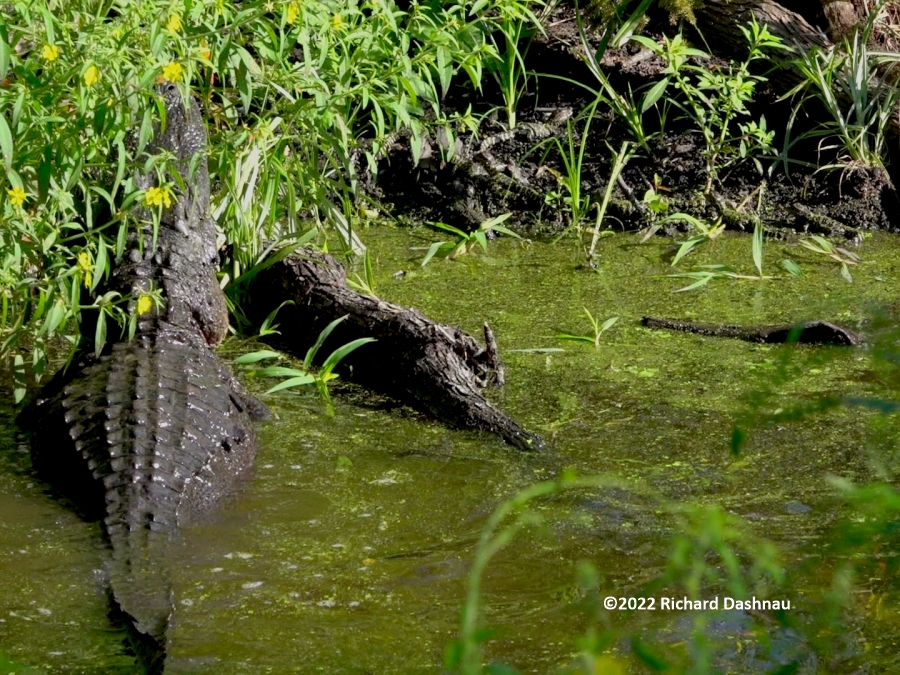
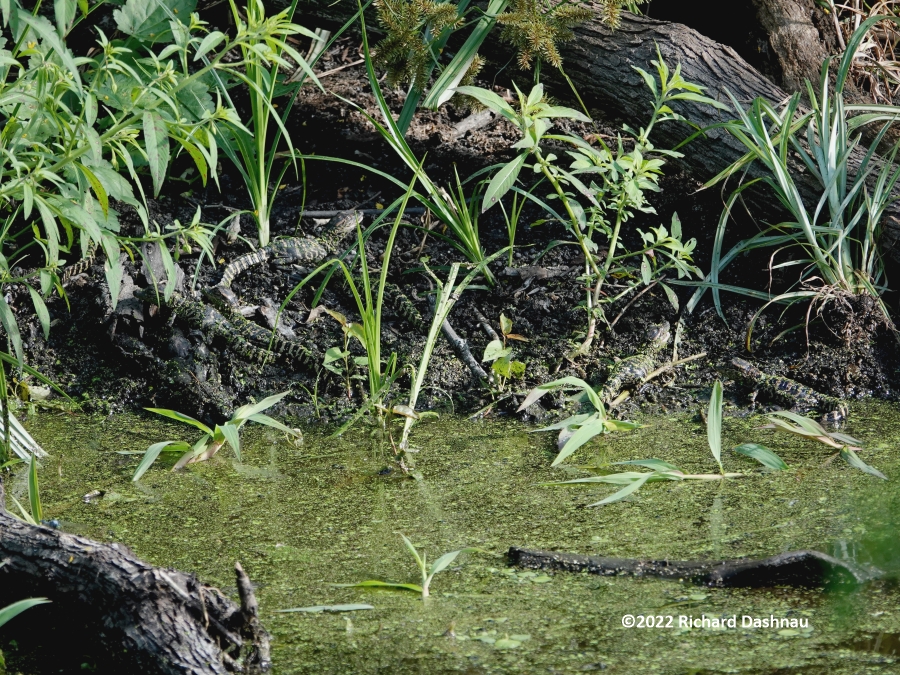
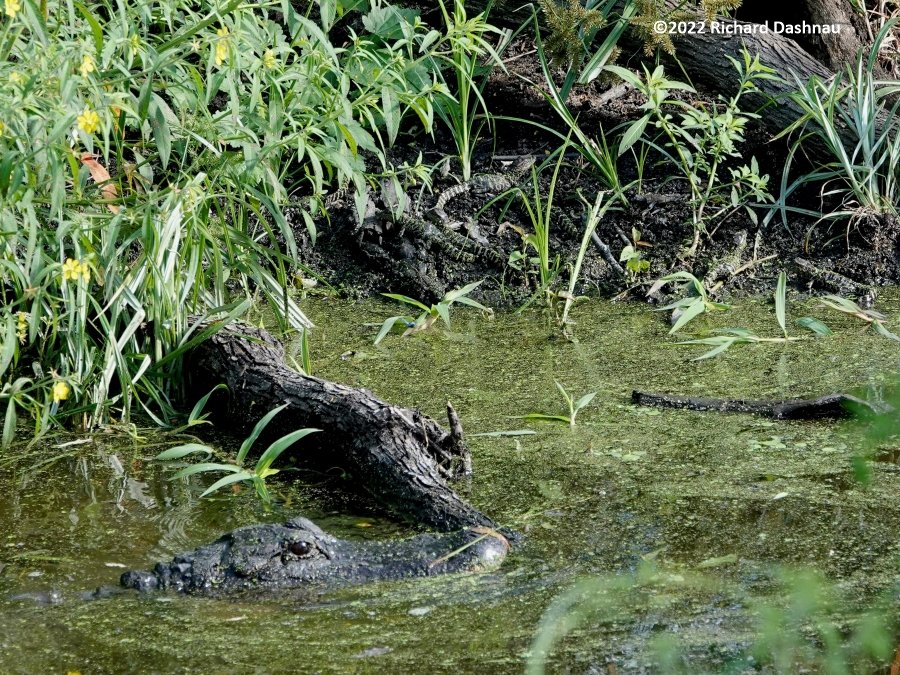

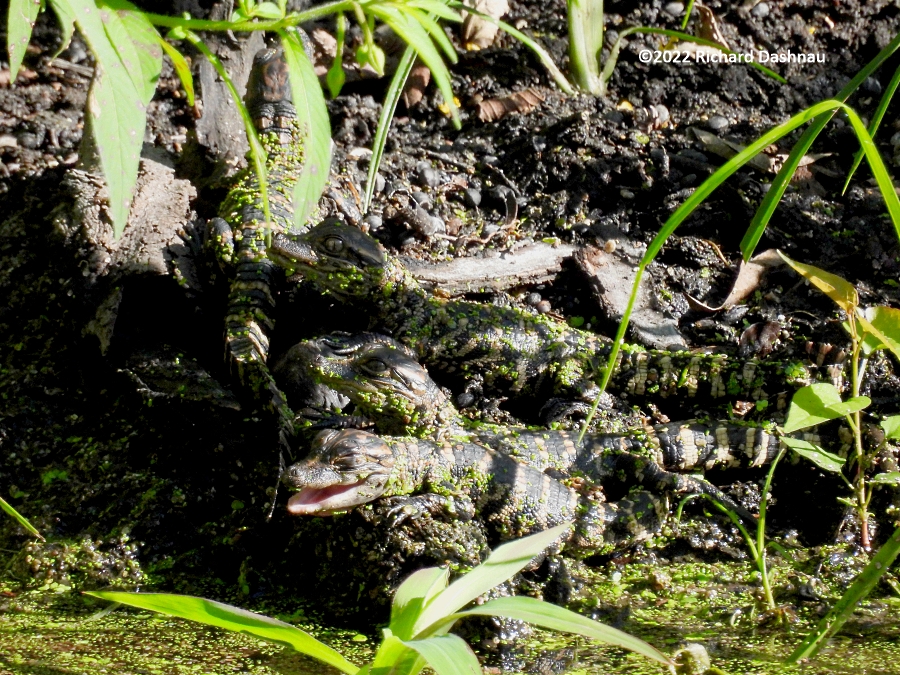
About
15 minutes after she answered the other gator's bellow, mom
gator
started moving East. She moved slowly, but without pause. There
aren't
any images of this, because of the thick
new plants obscuring her
progress. She stopped about 70 yards away (I paced it off
as
70
big steps), and moved up the bank. As gators often do (at least
the
ones I've seen) it stopped at
the edge of the trail. Then, it
lifted its hips (at first glance this might appear to be
preparation
for a quick run--but it isn't) and...pooped. This also happens
fairly
often. I've witnessed it, and
tracks in the dirt where alligators
have crossed will show little gator-sculpture trail
markers.
The
first image below left shows this activity. Then, the gator
crossed the
trail. It moved into the
thick plants with difficulty. It
turned right (turning West again) and started pushing back in
that
direction. During talking with visitors, and other
distractions--I lost
track of her in the weeds.
I did see movements there that might have been her, but I left.
Here
is an example of a female alligator leaving hatchlings alone
while she
carries out gator business. The babies have to rely on their
location(shaded, covered area) and behavior
(hide, be still) to help
them keep alive while their mother is gone. One of our
many
species
of wading birds or raptors; or other predators like otters,
raccoons,
etc. could eat them--but
it
would have to find the babies first. If you missed the
link
above, again--you can see video here.
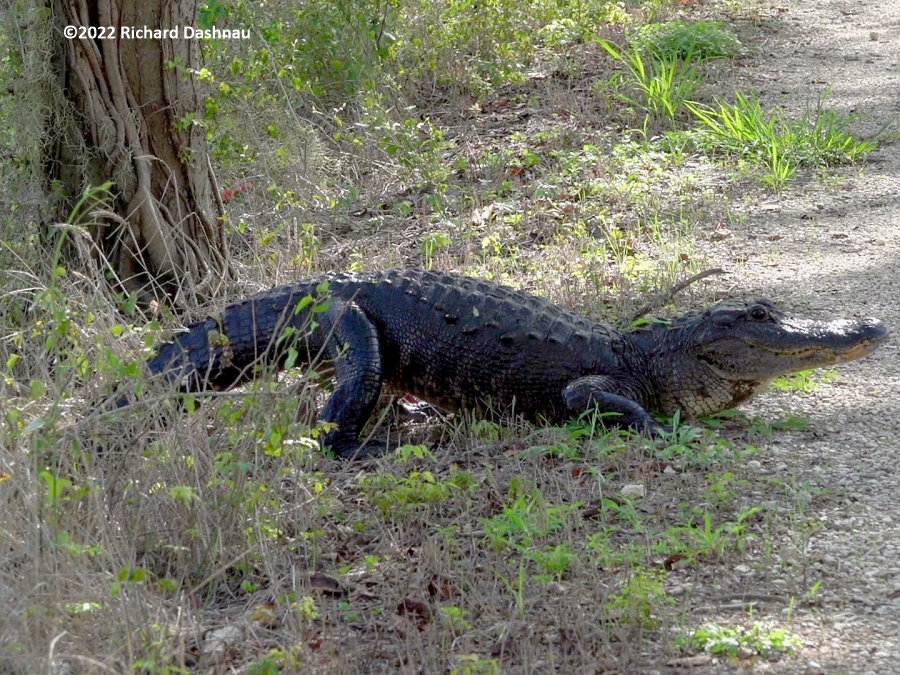
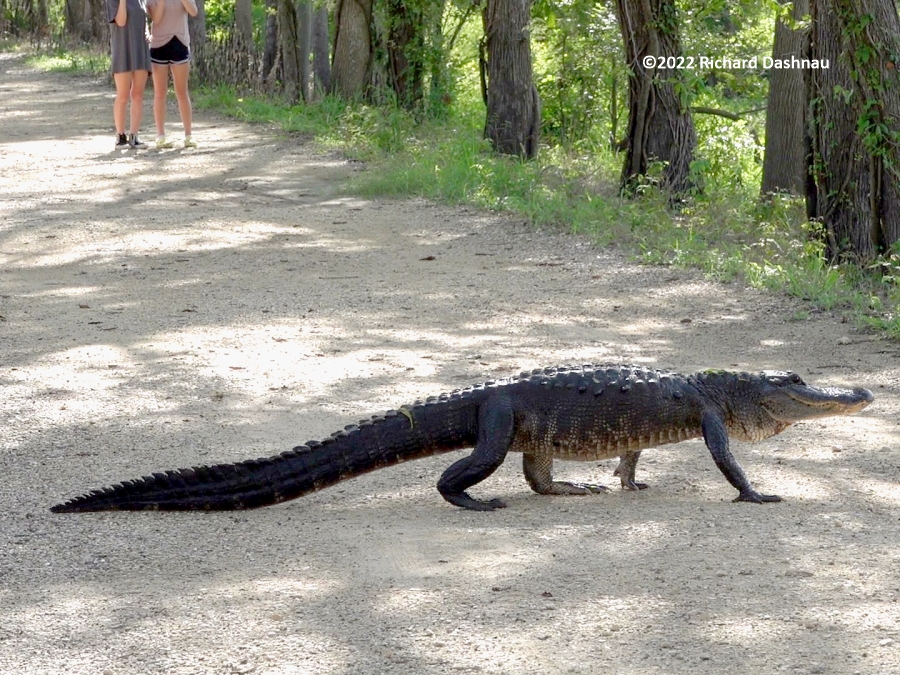
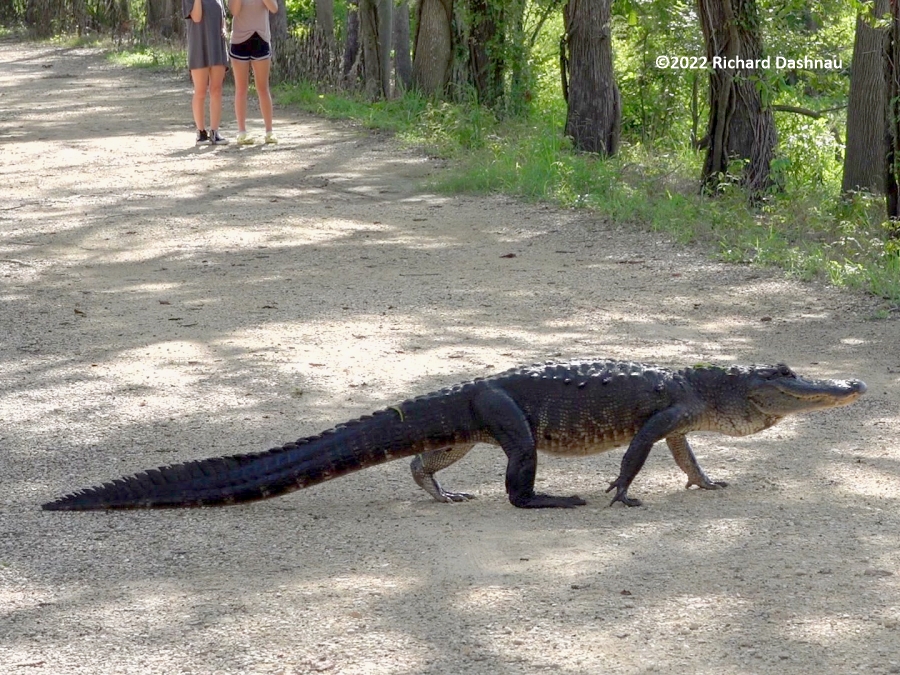

From
Brazos Bend State Park
on 08/14/2022
For this
update,
first, two pictures taken on August 14, 2022, showing the
alligator
nest that was near
the
Spillway Trail. On this page, there are also two sets of
pictures
taken earlier (July 3rd, August 7th) that show conditions
around the
nest. Arrows in the first picture show
the nest and the mother
alligator. The second picture is a zoomed view, taken a few
steps to
the right. Alligators usually hatch around the end
of August
(possibly
a week or so either way), so I wondered how the hatching would
turn out.
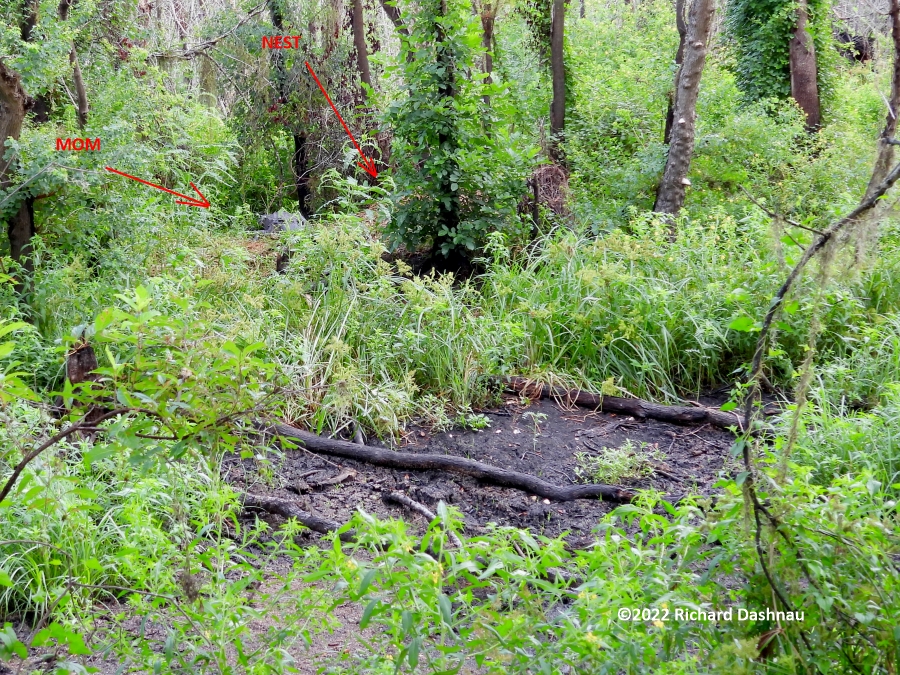
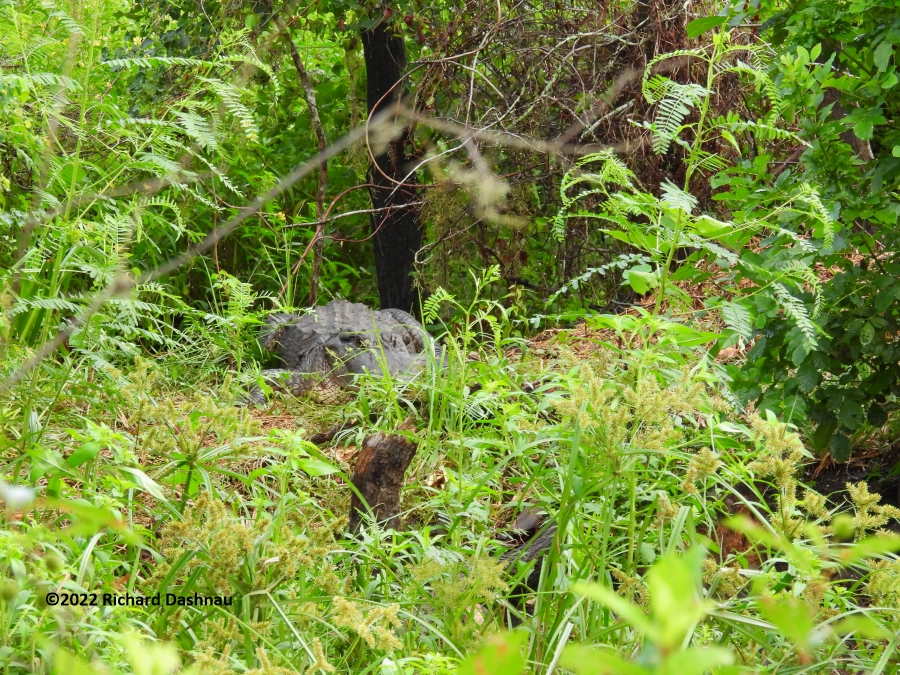
From Brazos Bend State Park on 08/07/2022
(mostly)
The
lack
of rain has had effects felt through the all of Texas.
Brazos Bend State park has not been exempt from
this. All of
the lakes in the park are usually fed by rainfall--unless a
flood comes
and inundates everything. Therefore, water levels in all the
lakes have
been going down. Pilant Lake had the
additional problem of water
lost while unavoidable drainage repairs were completed. The
relatively
rapid changes in Pilant Lake has inspired many kinds of animal
behavior, and I have
collected many observations--which I'm trying to arrange into
use able
narratives. This update is a short one.
There
is an alligator nest a little East of the middle of the Spillway
Trail.
This is the section of trail that connects the 40 Acre Lake
Trail
(starting at the Tower) and the Elm Lake Trail. It's
about 50
paces East of nesting box #21, North of the trail. As I've
mentioned
before, the entire North side of the Spillway Trail is usually
irrigated by Pilant Lake. With Pilant Lake drying up,
the water
along the way has gone, too. The water had already receded a lot
by the
time I saw the nest on July 3rd and took a few pictures. Those
are the
first two images below. The next
two image, taken August 7th, show how much it has dried.
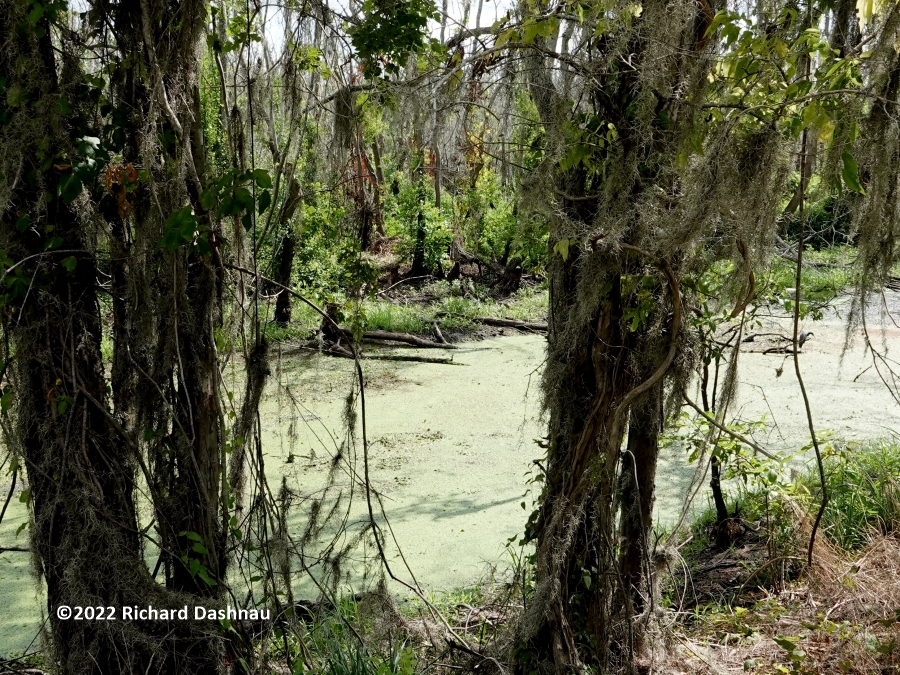
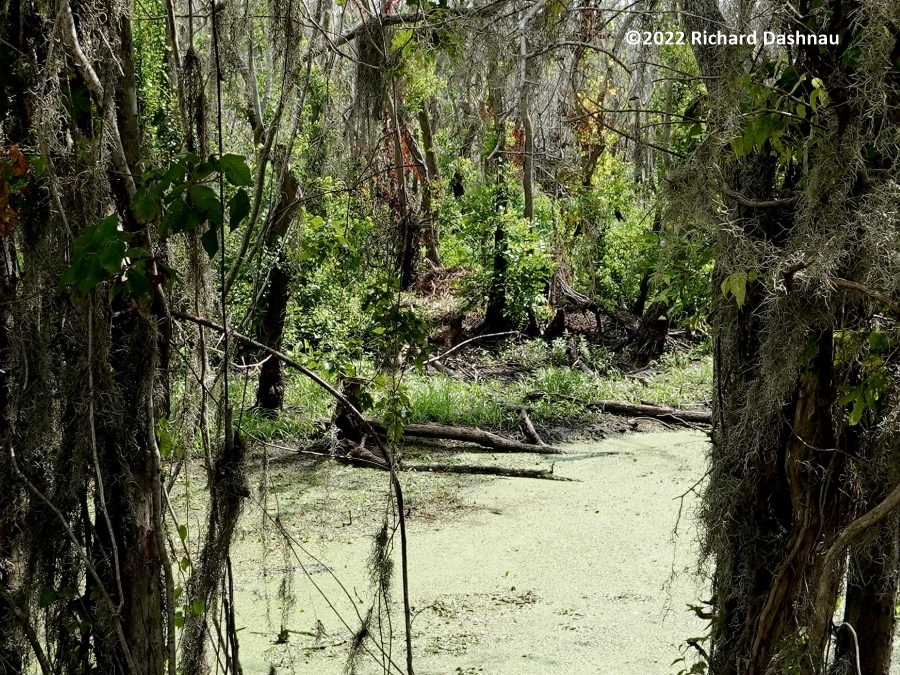
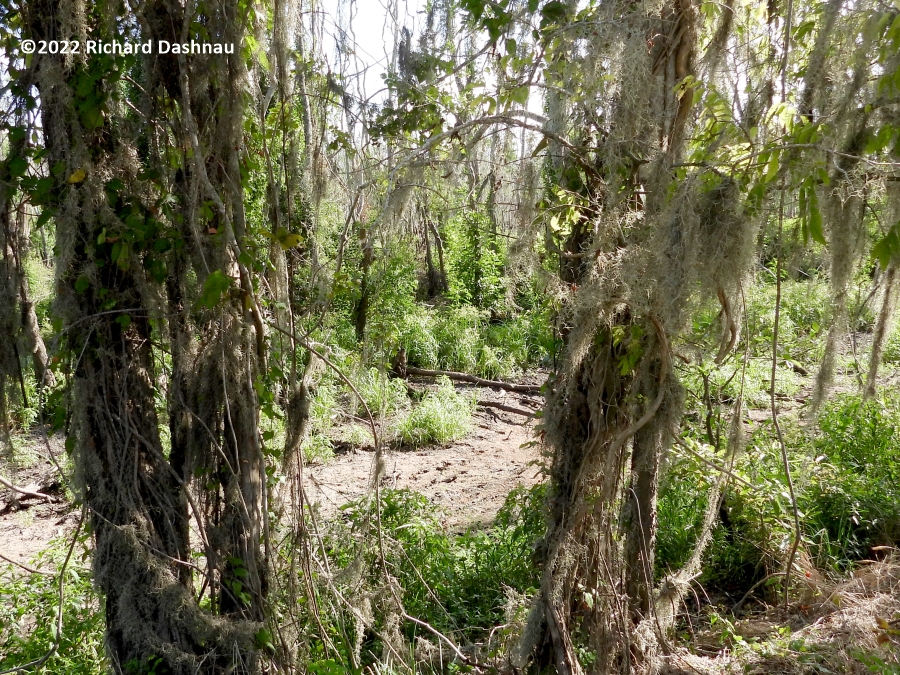
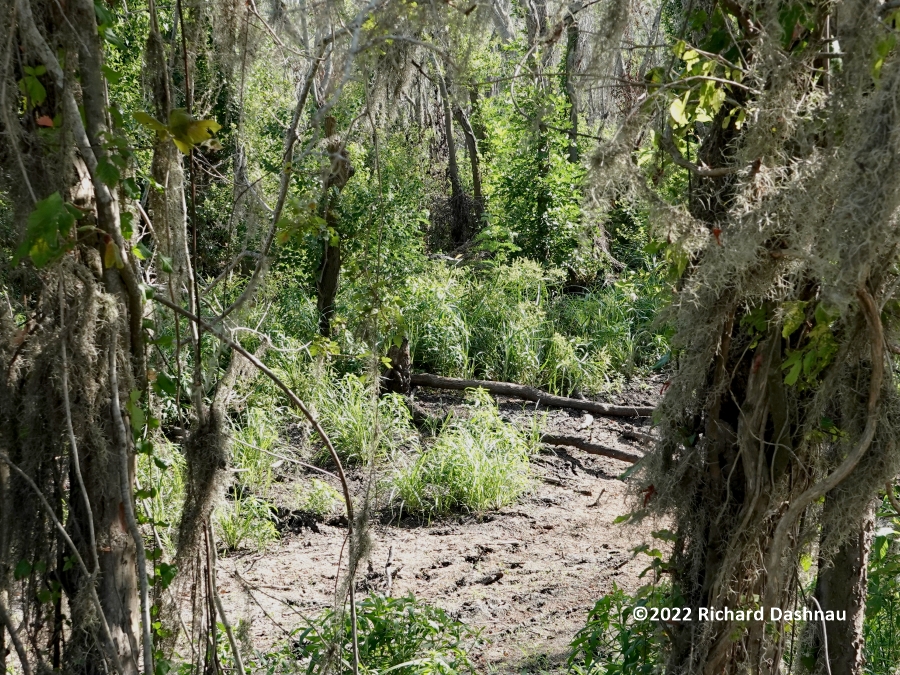
July
03, 2022
July 03, 2022
August
07, 2022
August 07, 2022
There
is
another difference between the two sets of images.
It's
a bit hard to see in the two images from August 7th above. The
images
below will make it clearer. That's most likely
the female that owns
the nest! I was very surprised to see her there. Even though it
was
about 9:30 am, it was already hot (mid 80's F I think), and
there was NO
water visible nearby. She was
gone
by the time I returned later in the day. Over the 20 years I've
been at
BBSP, I've seen it this dry before, and have watched a pod of
babies in
a puddle in that area as it shrunk to nothing
over a period of
weeks. Some time later, the rain returned, and the
water...and
some babies appeared in the puddle! Where had they gone?
It's
probable that the mother gator had dug
a den in the vicinity--and they had sheltered in it.
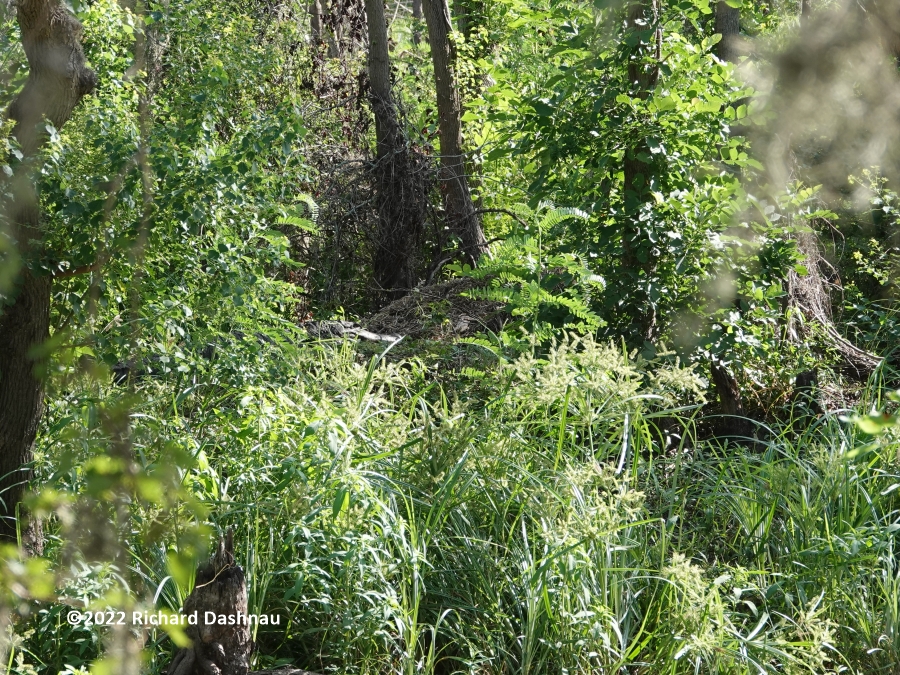
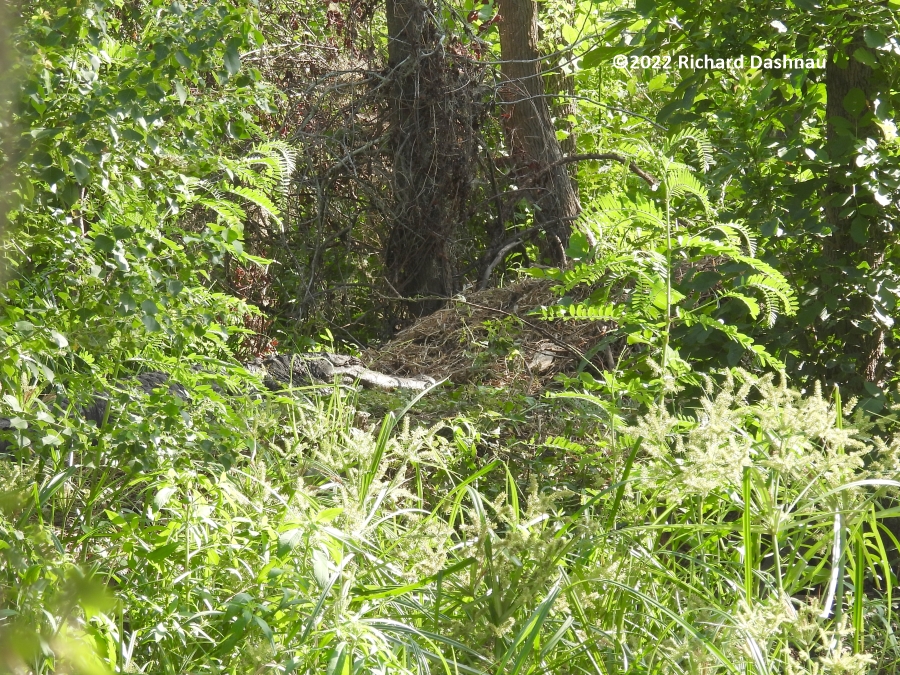
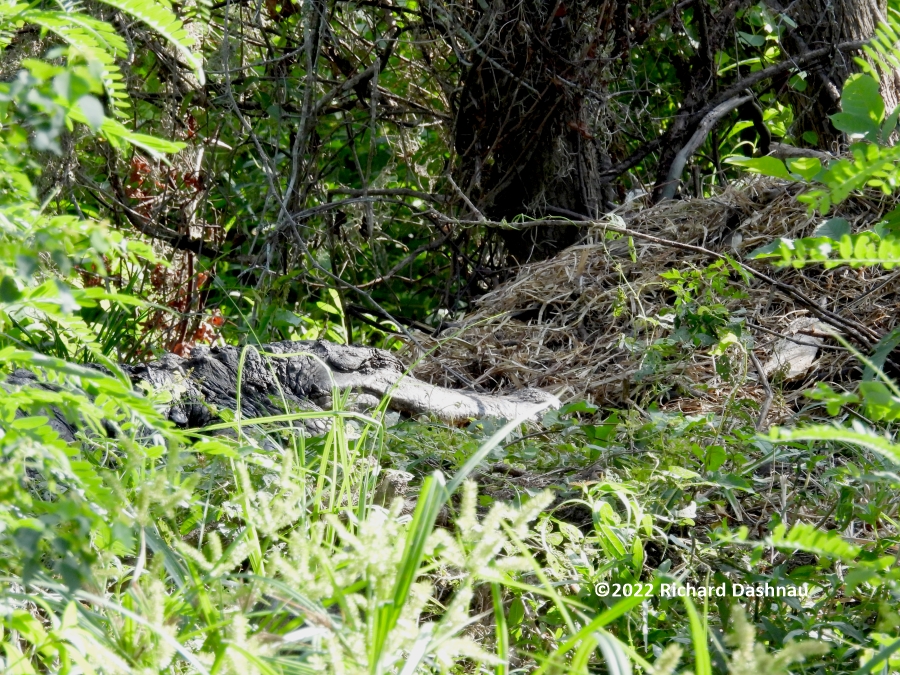
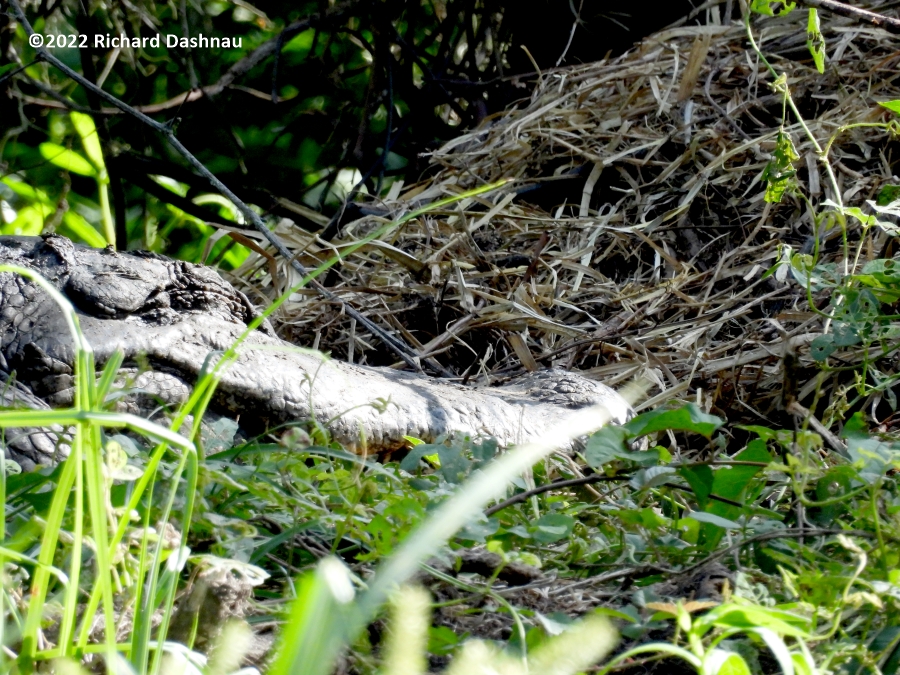
August
07, 2022
August 07, 2022
August
07, 2022
August 07, 2022
04/24/2022 Last,
here is some bad news. Around 4:00 I was at the West side of
Pilant
Lake, and I'd found the really large mother alligator there. I
could
identify her by the babies that
were moving around and on her.
That's not the bad news. The bad news is the pink mass
of snail eggs that I saw right next to her.
I've heard
other reports of snail eggs at other spots in the
park; but this is the
first time I've seen them. There may be another small mass of
them
in the upper left background of picture 03 (I didn't notice
them when I
took the picture, so I don't know).
Otherwise, we can enjoy seeing
the mother alligator and her babies. At least one of the
babies
near her seemed to be much larger, so they were probably a
year older
than the others. I shot
a few video clips as well, and here's a short film (2 min) showing the babies
and their mom. (Added video 4/29/2022)
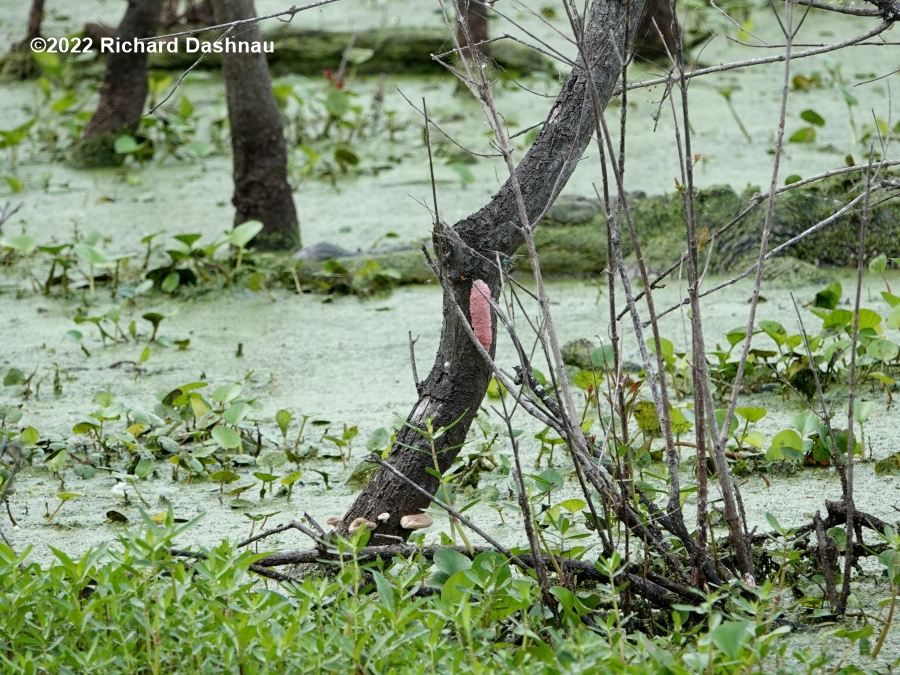
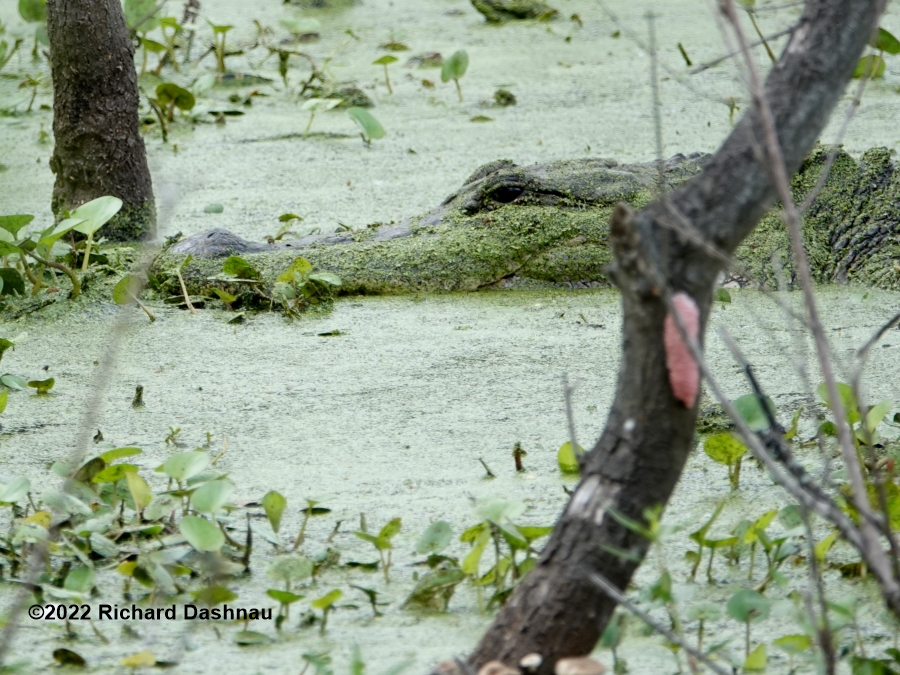
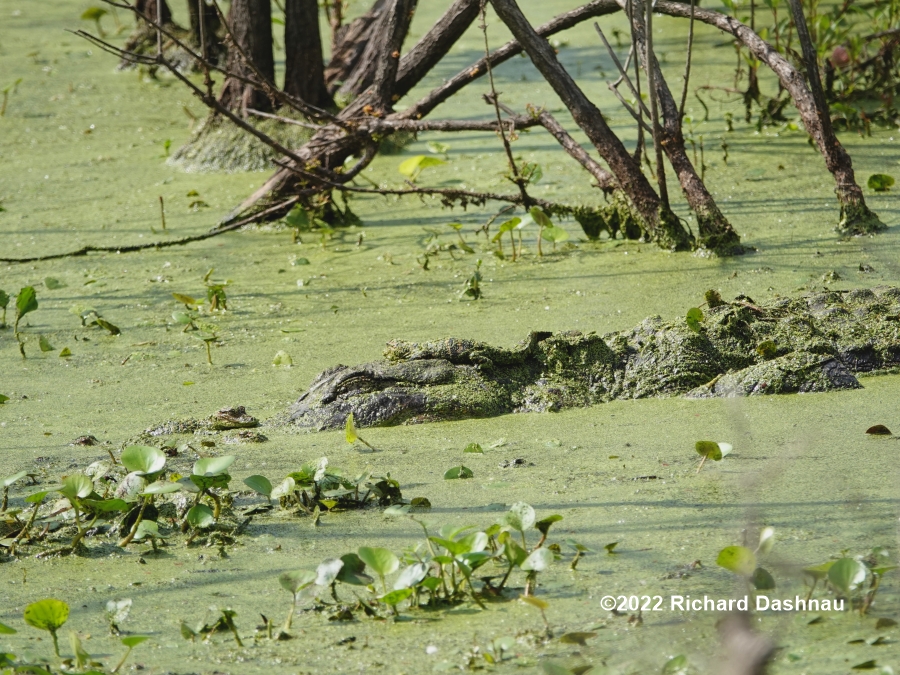
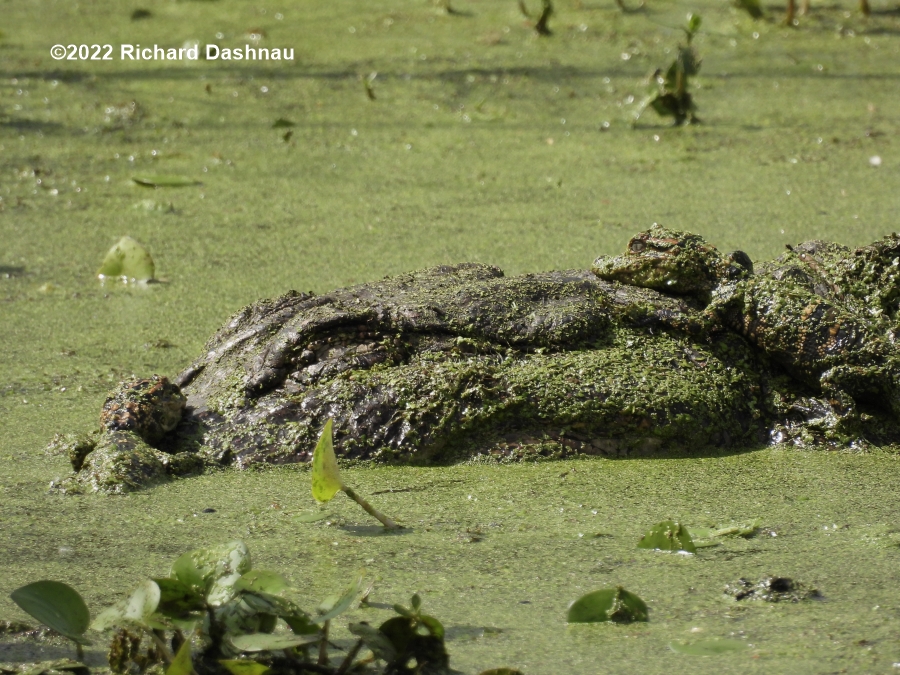
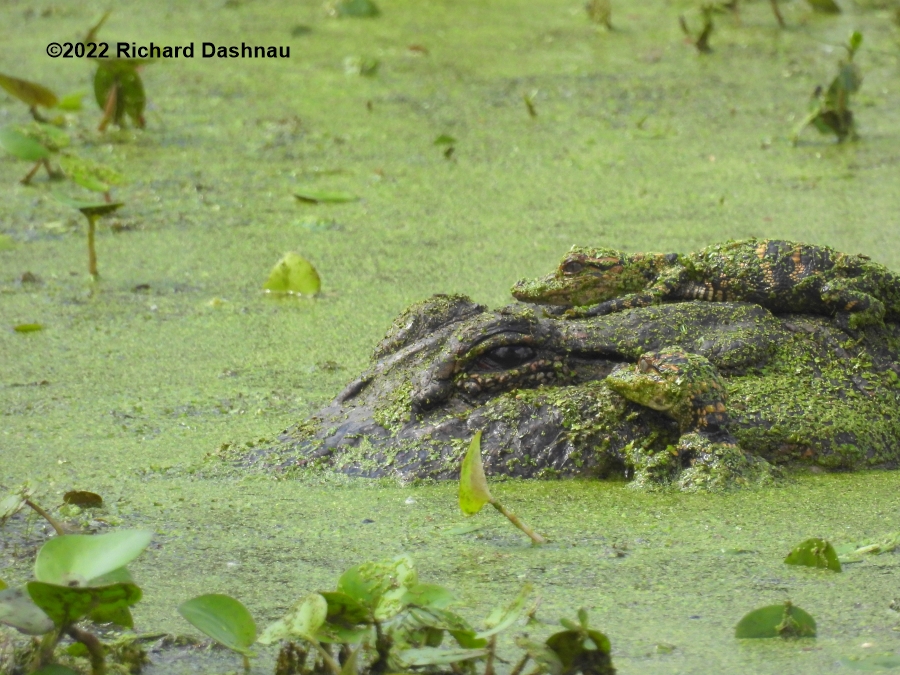
And,
this page shows
alligators at the park, on land, near various landmarks at the park.
Go back to my
main alligator page, Alligators
Go
back to my home page, Welcome
to rickubis.com
Go
back to the RICKUBISCAM
page.
Go
back to the See
the World
page.










































































